|
Green Gift Ideas for New Moms |
In December 2018, Green America’s membership, marketing, and operations director Dana Christianson welcomed her first child, Eustace, to the world. Naturally, she had put together a baby registry out of products that came from Green Business Network members. Now that she’s tried the products for herself, here’s her favorite mama must-haves, whether you're a new parents yourself or are looking for green gift ideas for new moms. She suggests online baby registries like Babylist so you don’t have to register at a big box store to make your registry accessible for your friends and family. Instead, you can link to businesses that share your values like and have the green, non-toxic products you want!
Traditional Medicinals, has lots of tasty teas and Mother’s Milk Tea ($5.29) is one especially made to promote lactation. As a first-time mom I was happy to find this had great reviews.
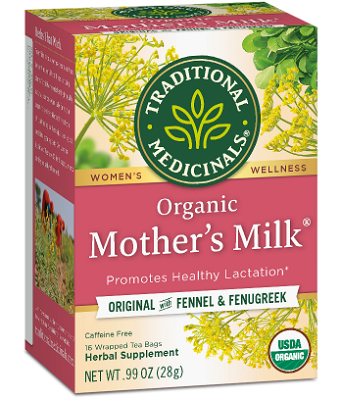
If it’s not broke, don’t fix it. These simple Nursing Pads ($4.50/pair) from Decent Exposure are six layers of 100 percent cotton and are soft and absorbent.

Is there anything cuter than a beach baby?
This bright Swim Diaper ($15.75) from Thirsties comes in five adorable prints and is “trimmed up” to meet requirements of public pools (that means worry free!).
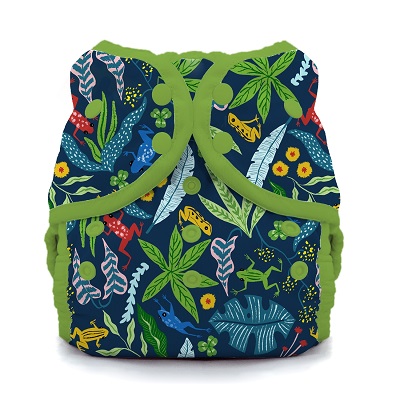
This bassinet and stand is absolutely dreamy, isn’t it? The stand ($159.90) is from Baby Eco Trends made of solid wood and built in the US. It’s built to pair with the Moses Basket from Plum & Sparrow.

It feels natural to be careful with what’s going into baby’s mouth. The Baby Buddy Teething Toy ($26 for two) is made of GOTS-certified organic cotton and fair trade certified. It’s also free from AZO colorants, BPA, flame retardants, formaldehyde, fragrance, PVC, and lead (phew!) from Under the Nile.

Some gifts are less glamorous than others...but you know this will get used. Earth Mama Organics’ Organic Nipple Butter ($12.99) is lanolin-, petroleum-, and paraben-free, and non-GMO certified, which is important, since the baby might end up eating a bit of it. It’s also so soothing, of course.
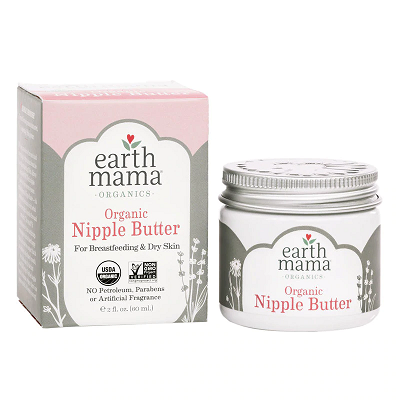
It’s never too early to start kids caring about the Earth and the people on it. Fair Trade Winds sells A is for Activist ($10) to teach kids about environmental justice and human rights—oh, and the alphabet.
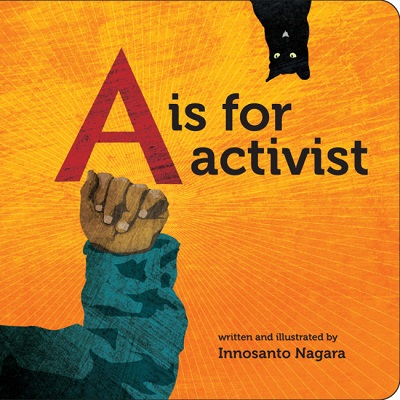
Cloth diapers can be a big investment but this one is amazing because GroVia O.N.E. ($22.95 each with a discount for multiple purchases), grow with your baby. Cloth diapers can save money in the long run because these fit from birth through potty training. The Green Nursery thought of everything, like hook and loop closure and a snap closure.

Whether you're a new parent or on your way to a baby shower, the best gift ideas for new moms are green! Shop these products and more at GreenPages.org.
|
|
Chocolate companies don’t do enough to stop child workers, new report says |
Major chocolate companies such as Godiva, Lindt and Hershey are failing to make sure their suppliers don’t use children as workers, according to a new ranking by activists released last week.
Godiva was rated the worst, followed by Ferrero and Mondalez on a scorecard of efforts to reduce child labor and deforestation published by the activist group Green America.
Mars and Nestle were rated slightly better than Lindt and Hershey, while seven smaller companies received the best grade, including Alter Eco, Divine and Tony’s Chocolonely.
Most of the world’s cocoa is grown by poor family farmers in the West African countries of Ghana and Ivory Coast, where an estimated 1.6 million children work in the industry.
While companies are making efforts to fix the problem, Green America said it is too early to see results for some, while others received low grades for not revealing all of their suppliers.
“This Halloween and every day, children should be able to enjoy candies that aren’t made by child laborers,” said Charlotte Tate, Green America’s labor justice manager.
“Big brands must do more to tackle these issues, and buying ethically sourced chocolate is one way for consumers to put pressure on brands to change their practices,” she said.
Godiva, which received the worst ranking, said it purchases cocoa through third parties, which put it at a scoring disadvantage.
“We ensure ethical sourcing through agreements with our suppliers to comply with our Godiva Code of Conduct, which explicitly prohibits the use of forced and child labor,” a company spokeswoman said in an email.
Other companies did not immediately respond to requests for comment.
Most major chocolate companies are working to increase the percentage of their cocoa that is certified as ethical by groups such as Fair Trade and Rainforest Alliance, or through their own certification programs.
Many have the goal of sourcing 100 percent certified cocoa by 2020.
But Green America said buying certified cocoa is not enough. It said there are related issues such as whether companies had initiatives to support communities and raise farmers’ pay.
Most cocoa farming families live below the World Bank’s poverty line of $2 a day. The poverty encourages child labor, according to the charity International Cocoa Initiative (ICI).
Ghana and Ivory Coast on Thursday said that cocoa companies were too focused on their own sustainability plans instead of a payment plan to help farmers.
“The two countries [are] therefore re-examining all sustainability and certification programs for the 2019/20 season,” they said in a joint statement.
|
|
Try Sustainable Clothing from these Green Brands |
Sweat Stylishly
Exercise isn’t part of everyone’s daily routine, but men and women who do try to fit in a workout can find casual 100 percent organic T-shirts at Natural Clothing Company for $19.

You can find a similar t-shirt style at EConscious for $18.

Blue Canoe also offers a variety of camisoles and tanks made from a mixture of organic cotton, rayon, and spandex.

Work-Wear
The elegant Natalay Wrap Dress from Ash & Rose ($69) is made with cotton rescued from factory waste and crafted by fair-trade partners in Cambodia.

Folks looking for pieces that can be dressed up or down may be drawn to the Sheng Trousers ($64) which are made from 97 percent organic cotton and 3 percent spandex twill.

Anna Herman’s also offers a variety of clean-cut hemp shirts for men for $49. For pants, Anna Herman's offers men’s Wool Check Pants for $89.

Happy Hour
Ooloop’s Cleo Skirt ($78) is a classic red mini made with organic cotton and a spry statement piece for an outing to your favorite happy hour spot or night club.

Ooloop also has crisp light blue Nacka Chino shorts ($63) which are made with soft organic cotton.
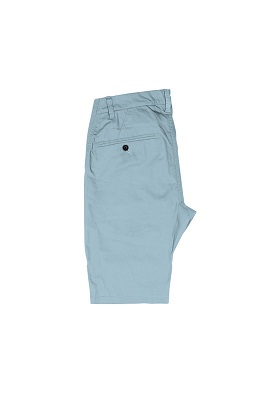
Green and Cozy
Men and women can find comfy loungewear at Natural Clothing Company’s online store. Options include the Organic Crew Undershirt ($27) for men, which is made in the US of 100 percent unbleached organic cotton.

The company also sells women’s robes made with 95 percent viscose bamboo and five percent spandex ($46).

The next time you add to your closet, explore sustainable clothing options or better yet, buy secondhand!
|
|
Pekin Hardy Strauss Wealth Management |
At Pekin Hardy, based in Chicago, Illinois, we’ve been helping our clients navigate the challenges of the market and their own financial lives for almost three decades. Our years of experience in wealth management have taught us to be prudent value investors in the style of Warren Buffett and to do our own independent research on potential investment opportunities. We have also learned that every client is unique, so we can provide personalized services to those who work with us to achieve their financial goals.
As a fiduciary and fee-only adviser, we put our clients first, and we are committed to providing our clients with independent financial advice. Pekin Hardy is a certified B Corporation, which means that we are committed to meeting the highest standards of impact investing, social and environmental performance, public transparency, and legal accountability.
|
|
Sunshine Debris Removal LLC |
Our mission is to bring our customers the most affordable and the highest quality of Debris removal service. We hope to enhance our communities, and the environment by donating, recycling, and removing waste one job at a time. |
|
Major Candy Companies Face Sustainability and Child Labor Issues, According to This 'Chocolate Scorecard' |
Chocolate is already known as a guilty pleasure, but a new report might leave you feeling legitimately guilty about the path cocoa takes to reach some of your favorite sweets. Green America—a non-profit dedicated to creating "a socially just and environmentally sustainable society"—recently released its "Chocolate Scorecard" for 2019, looking at child labor, deforestation, and farmer poverty in the chocolate industry. And the world's largest brands landed some of the worst grades.
Godiva was the only brand to score an "F," but Mondelez and Ferrero weren't far behind: Both brands were graded "D." Lindt and Hershey were also flagged with a "C," while Mars and Nestle performed the best out of the big names, but only by both scoring a "C+." Finishing off the list from the bottom up, Guittard got a "B+," while Alter Eco, Divine, Endangered Species, Equal Exchange, Shaman, Theo Chocolate, and Tony's Chocolonely all scored an "A."
So how were the scores determined? "Chocolate bars with an 'A' rating are addressing farmer income and child labor issues, and are organic and/or non-GMO certified," Green America writes. Beyond that, the group states, "We are not only looking at how much certified cocoa a major chocolate company has, we are also looking to see if the company has innovative programs and projects in place to address some of the other underlying issues of child labor in cocoa and if the company is working to address deforestation."
"When bombarded with endless choices, it can be difficult to know which chocolate brands are having a positive impact on the world," Todd Larsen, executive co-director of Consumer and Corporate Engagement at Green America, said in announcing the results. "The aim of Green America's scorecard is to help consumers feel confident about choosing chocolates that are ethically sourced with high-quality ingredients."
Importantly, however, the scorecard itself does highlight certain symbols consumers can look for. Green America highlights five certification programs: Fairtrade, Fair Trade Certified, IMO Fair For Life, Rainforest Alliance, and UTZ all prohibit companies from using forced labor and child labor to bear their seal. And these programs are separate from companies' own programs which "can vary in practice in regards to how comprehensive and impactful they are," Green America writes.
In the end, the organization made it very clear what they want the takeaway from the scorecard to be: "Big brands must do more to tackle these issues and buying ethically sourced chocolate is one way for consumers to put pressure on brands to change their practices," stated Charlotte Tate, labor justice manager at Green America.
At the same time, you probably shouldn't simply take a letter grade's word for it: Thankfully, Green America also provides a more in-depth analysis of how the largest seven brands can improve on their website.
|
|
Major Candy Companies Face Sustainability and Child Labor Issues, According to This 'Chocolate Scorecard' |
Chocolate is already known as a guilty pleasure, but a new report might leave you feeling legitimately guilty about the path cocoa takes to reach some of your favorite sweets. Green America—a non-profit dedicated to creating "a socially just and environmentally sustainable society"—recently released its "Chocolate Scorecard" for 2019, looking at child labor, deforestation, and farmer poverty in the chocolate industry. And the world's largest brands landed some of the worst grades.
Godiva was the only brand to score an "F," but Mondelez and Ferrero weren't far behind: Both brands were graded "D." Lindt and Hershey were also flagged with a "C," while Mars and Nestle performed the best out of the big names, but only by both scoring a "C+." Finishing off the list from the bottom up, Guittard got a "B+," while Alter Eco, Divine, Endangered Species, Equal Exchange, Shaman, Theo Chocolate, and Tony's Chocolonely all scored an "A."
So how were the scores determined? "Chocolate bars with an 'A' rating are addressing farmer income and child labor issues, and are organic and/or non-GMO certified," Green America writes. Beyond that, the group states, "We are not only looking at how much certified cocoa a major chocolate company has, we are also looking to see if the company has innovative programs and projects in place to address some of the other underlying issues of child labor in cocoa and if the company is working to address deforestation."
"When bombarded with endless choices, it can be difficult to know which chocolate brands are having a positive impact on the world," Todd Larsen, executive co-director of Consumer and Corporate Engagement at Green America, said in announcing the results. "The aim of Green America's scorecard is to help consumers feel confident about choosing chocolates that are ethically sourced with high-quality ingredients."
Importantly, however, the scorecard itself does highlight certain symbols consumers can look for. Green America highlights five certification programs: Fairtrade, Fair Trade Certified, IMO Fair For Life, Rainforest Alliance, and UTZ all prohibit companies from using forced labor and child labor to bear their seal. And these programs are separate from companies' own programs which "can vary in practice in regards to how comprehensive and impactful they are," Green America writes.
In the end, the organization made it very clear what they want the takeaway from the scorecard to be: "Big brands must do more to tackle these issues and buying ethically sourced chocolate is one way for consumers to put pressure on brands to change their practices," stated Charlotte Tate, labor justice manager at Green America.
At the same time, you probably shouldn't simply take a letter grade's word for it: Thankfully, Green America also provides a more in-depth analysis of how the largest seven brands can improve on their website.
|
|
Toxic Pink Packaging |
The European Union and other countries have banned over 1,600 chemicals from use in cosmetics. The US has banned 9. EU laws require that manufacturers prove chemicals are safe before they can be used in a product. In the US, chemicals are not always banned even if they potentially cause cancer; contain neuro- and immunotoxins; or contain hormone disruptors that could cause birth defects.
Cosmetics are very loosely defined by the FDA; the term encompasses perfume, moisturizer, makeup, nail polish, shampoo, hair dyes, toothpaste, and deodorant. Though the manufacturer is legally required to ensure the safety of a product, companies’ standards for safety may be quite different than what a customer might think—because many products still contain toxic substances like lead and formaldehyde.
According to the Environmental Working Group (EWG), women are exposed to 168 chemicals every day through cosmetics and personal care products, and those chemicals might be different each day, if you use multiple soaps or makeup items, for example. Men are exposed to 85 chemicals per day.
In its Skin Deep database, EWG clearly states that: “personal care products contain carcinogens, pesticides, reproductive toxins, endocrine disruptors, plasticizers, degreasers, and surfactants. They are the chemical industry in a bottle.”
Knowing that anything could be in your makeup drawer or bathroom counter is disturbing. Just because you’ve heard of an ingredient doesn’t make it safe. Baby powder, which often contains the carcinogenic mineral talc (you can buy a version that uses cornstarch), is the cause of 14,000 lawsuits adding up to an estimated $4 billion in fines against Johnson & Johnson for using the mineral in its products.
Unfortunately, vigilance is the only way to avoid toxic materials in your routine. In the Skin Deep database, you can search for cosmetics by name to see a list of ingredients and the toxicity of each, on a scale of one to ten. As of printing, the database includes 87,874 products. Head to EWG.org/skindeep to search your favorite products in the database.
I SMELL AN ISSUE
Scents are often a component of cosmetic products and are often included in menstrual products as well. Scent chemicals are called “fragrance” on an ingredients list, but that word can contain undisclosed chemicals of unknown toxicity and may contain allergens or chemicals linked to ailments such as allergic rash, endocrine disruption, and cancer, according to Women’s Voices for the Earth’s Chem Fatale Report.
MENSTRUAL PRODUCTS
If you use pads or tampons, you’ve probably seen commercials for all-natural organic versions. Gynecologists have tried to debunk these concerns (the chemicals involved in tampon production are trace), as a marketing ploy from companies that are greenwashing the products they sell.
Unfortunately, there are still causes for concern: namely products’ scents and plastic components. Pads and tampon applicators are made up of mostly plastic. Chemicals that may compose any given plastic, like BPA, BPS, phthalates, and DEHP, have been linked to reproductive system and liver damage. Organic cotton tampons are still better than conventional ones because of the benefits of growing cotton organically.
Luckily, there are options. Lunapads m sells washable cotton fabric pads, including the “Performa Super” pad, which can absorb the equivalent of four pads or tampons, according to the company. Lunapads also sells the DivaCup, which is a reusable menstrual cup that can be worn inside the body to replace tampons. They’re made from silicone, which unlike plastic, does not leach chemicals even when brought to a high temperature (such as boiling the product for cleaning), and resists the aging process of oxidative deterioration.
Choosing a reusable option, whether pad or cup, can save money on menstrual supplies. One cup costs $10-$40 and can last for years, compared to $7-$10 for a box of tampons or pack of pads which may last a month or two. If you’re not ready to switch to reusables, it isn’t hard to find tampons sold without an applicator, though finding plastic-free disposable pads is challenging.
There are many brands out there for applicator-free tampons, reusable pads, menstrual cups, and specially made absorbent underwear, which basically have built-in pads. You can find them wherever natural health products are sold, like from shops on GreenPages.org.
WHO IS MOST AFFECTED?
Women of color use more beauty products and are disproportionately exposed to harmful chemicals than white women, as published in a 2017 study in the American Journal of Obstetrics and Gynecology.
In 2016, Skin Deep analyzed 1,177 beauty products marketed to Black women and found one in 12 was ranked highly hazardous. Less than 25 percent scored low in potentially hazardous ingredients.
Ami Zota, a professor at George Washington University’s School of Public Health, has theorized that Black, Latinx, and Asian American women use more beauty products to meet societal pressure. They may also be exposed to more chemicals in harmful products because there are fewer natural products marketed to them, compared to white women.
The Green Business Network has certified many brands that focus on natural, nontoxic products, including those that are owned by women and women of color, which can be found at GreenPages.org.
Research suggests the market is ready for more natural products aimed towards women of color. Black women are estimated to spend 80 percent more per year on skin care than non-Black women, and that difference is estimated because Black women must sample many more products to find those that work.
“African American and Latina women want to be like everyone else and are buying what’s within their reach,” says Sylvia Walker, owner of NAIWBE, Natural As I Wanna Be.
Walker is a Registered Nurse and Certified Health Coach who started NAIWBE when she got frustrated by the effects harsh hospital cleansers and lotions had on her skin. She provides demonstrations of NAIWBE products and education on healthy lifestyle choices in Sam’s Club, one of the places she sells products. She loves to answer questions about what’s in the products customers are using and what they could be getting from natural products.
“Everyone wants to look good and feel food, and fit in,” says Walker. “A lot of people are more open today to speaking with their doctors, than 10 or 15 years ago. Because of the internet people read more, people ask more questions… instead of just buying based on marketing and TV ads with beautiful women.”
Updated March 2023.
|
|
Your Top 10 Plastics Questions, Answered |
Plastics have been in the news lately for being a major source of pollution. You might have questions, and you’re not alone. Here, we answer some of the questions we get asked most about plastics and recycling.
1. Does banning single-use plastic even make a dent in the bigger problem of climate change?
Yes! Plastic is derived from crude oil. Banning plastic puts pressure on its producer, the fossil fuel industry. Plastic bans also bring attention to climate change, pushes customers to reuse, and encourages businesses to create reusable options.
2. I’ve heard that China used to buy plastic recyclables from the US but has cut back? What should I do with my plastic recycling?
Every town has a different situation. To find out what your recycling program’s current policy is, contact your municipality. If they’re no longer taking certain plastics, try to avoid those in the store as much as you can. You can also inquire about local drop off facilities for those types of plastic.
3. How can I avoid bringing home plastic packaging from the supermarket? Some of this plastic is not recyclable through the municipal system.
Opt for produce that isn’t wrapped in plastic and bring your own bag to carry them in. If possible, buy from a farmers market where food generally is loose. If it’s a product you love, contact the company asking for non-plastic wrapping. Your consumer voice matters!
4. What are microplastics, and what kind of plastic is most likely to become a microplastic?
Microplastics are pieces of plastic that are 5 mm or smaller. They can be created to be that size–such as microbeads in soaps—and they can be broken bits of a larger plastic or material with plastic parts. A Friends of the Earth study of UK waters found that the four leading contributors are car tires (due to abrasion on the road), external paint (from buildings and road markings), plastic pellets (used to make plastic products), and synthetic fibers from clothing.
5. Are certain plastics worse than others?
Yes. Non-recyclable and non-reusable plastics are the worst in that they take several lifetimes to break down and leach chemicals like BPA in the process. Plastic straws have taken the limelight in the single-use arena, but abandoned fishing gear, plastic bags, cigarette butts, and food packaging (including water bottles) are the more commonly found debris in the ocean.
6. What do the numbers on the bottom of plastic products mean?
Plastic is coded with numbers 1-7 that designate material. Not all plastics are recyclable, and some aren’t reusable. Refer to your local recycling center’s guidelines of what numbers are accepted at search.earth911.com
7. Why is so little plastic recycled?
Plastic is the most complicated material to recycle because each number designates a different polymer design–in other words, a #1 can’t be recycled with a #5 because they melt at different temperatures. Municipal funding levels, community pressure, and demand for recycled plastics determine what gets recycled. Unlike metals like aluminum that can be recycled indefinitely, plastics degrade each time they’re processed, making recycling more expensive than manufacturing new plastic.
8. Is it ever environmentally helpful to have plastic-wrapped food to keep food from being wasted?
Plastic wrap extends shelf life by regulating contact with air. Since food waste has a larger carbon footprint than any country except China and the US, reducing waste is important. However, alternatives to plastic wrap like Bee’s Wrap, Green America’s People and Planet Award Winner, achieve the same goal while being reusable and eco-friendly.
9. Most vegan non-food products are made of plastic, like faux leather shoes. Is there a better alternative?
Many vegan clothing companies use recycled plastic as a leather-free alternative, but plastics in clothing still break down into microplastics that marine life consume. Consider buying secondhand.
10. When we ban plastic, doesn’t that force us to use other materials that are more expensive and energy-intensive? Shouldn’t we keep using it, but get better at recycling it?
While plastic bans are a recent trend, the reality is that plastic has become so integral to society that it won’t disappear soon. We should get better at recycling it, but that alone won’t solve the plastic problem. While alternatives may be more energy-intensive and expensive than plastic, reusables last longer than single-use plastic and may be indefinitely recyclable or compostable, making their overall carbon footprint lower. Lowering our consumption of plastics, not buying to begin with, and opting for reusables are less energy-intensive than consuming more.
Interested in learning more?
Here are eleven easy ways to kick the plastic habit. And a challenge: could you go entirely plastic-free?
|
|
10 Ways You Can Fight Climate Change |
Green America brings together consumers to pressure major polluters to take the climate crisis seriously. We also help individuals tackle climate change in their own homes and communities. Here are ten ways you can fight climate change and even contribute to an equitable, green economy!
1. Eliminate Food Waste
Food waste in the US occurs mostly in stores and at home—either because it spoils on the store shelf or before we can eat it. According to an NRDC study, Americans throw away up to 40 percent of the food they buy. We can combat food waste by shopping for what you need, eating leftovers, composting scraps, and donating excess to food banks. You can find a local food bank at FeedingAmerica.org. Project Drawdown estimates that curbing food waste could avoid a whopping 70.5 gigatons of CO2—that’s a bigger impact than restoring 435 million acres of tropical forest.
2. Eat Plant-Based
Transitioning to a vegetarian diet can cut your carbon footprint in half, and going vegan, even lower. Even shifting from high to low meat consumption can shrink your footprint by a third, according to a University of Oxford study. If half of the world’s population reduced meat consumption and avoided the associated deforestation caused by agriculture, we could reduce carbon emissions by 66 gigatons.
3. Use Clean Energy
Renewable energy is fundamental to powering the world as we move away from fossil fuels. Modeled after World War II “war bonds,” Clean Energy Victory Bonds—a bill introduced to Congress by Sen. Udall (D-NM), Reps. Lofgren (D-CA), and Reps. Matsui (D-CA)—would offer Treasury bonds as low as $25 to finance the government’s clean energy programs. Ask your representatives to support this bill to make Clean Energy Victory Bonds a reality. Additionally, you can purchase renewable energy from installers such as Blue Pacific Solar and RGS Energy, as well as plug into renewable utilities with Clean Choice Energy and Arcadia Power, which don’t require you to install any new hardware in your home to get sun- and wind-power.
4. Participate in the Democratic Process
Climate change has implications on local, national, and global levels. While the average person isn’t responsible for governing a nation, we are responsible for deciding who does. Vote for a climate activist, support comprehensive climate policies, and use your citizen voice to contact legislators when you disagree. The results of upcoming elections will determine how Americans and their elected leaders grapple with catastrophic climate change.
5. Divest
The largest source of greenhouse gas emissions come from fossil fuels. Divesting means taking your money out of institutions that fund fossil fuel expansion, which could eventually dry up funding to those projects. So far, the fossil fuel divestment movement has removed $9.94 trillion dollars from fossil fuel companies because of institutional divestments and $5.2 billion thanks to 58,000 individual divestments. You can build a fossil-free portfolio with our nationwide network of socially-responsible investing financial advisors which you can find on GreenPages.org, through our list of financial products and services, and by encouraging your faith organization or alma mater to divest.
6. Improve Insulation
One of the most cost-effective and accessible tactics to combating the climate crisis is better insulation. Older homes can lose up to 35 percent of heat through their walls. Modern insulation reduces the energy needed to heat a home, therefore reducing emissions and saving you money. If even half of existing buildings installed thicker insulation, 8.3 gigatons of emissions could be avoided—that’s more than overhauling efficiency for the entire international shipping industry.
7. Use LED Lighting
LEDs (light-emitting diodes) use 90 percent less energy than incandescent bulbs and half as much as compact fluorescents. They convert electrons to photons, effectively using electricity to create light without giving off heat, which wastes energy. Switching your home to LED lights will reduce cooling bills. They also last longer than other bulbs, so choosing them will bring long-term savings. According to Project Drawdown, universal adoption of LEDs could prevent 7.8 gigatons of carbon emissions.
8. Rethink Transportation
Overhauling the world’s transportation systems, both commercial and personal, would save as much CO2 as one billion acres of regenerative agriculture. Commercial trucks alone account for six percent of the world’s emissions—more than the collective emissions of airplanes around the globe. While individuals can’t revolutionize the shipping, flight, and automobile industries overnight, we can demand they change by voting with our dollars for public transit, using electric or hybrid vehicles, and reducing our total trips taken.
9. Recycle
Acquiring virgin resources—from logging trees to mining minerals—exploits more resources than recycling existing materials. For example, recycled aluminum products use 95 percent less energy than creating new ones. About 50 percent of recycled materials come from households; if that number were to increase to 65 percent, at-home recycling could prevent 2.8 gigatons of carbon emissions. However, recycling wrong can slow the system and create more waste, so be sure to rinse out your recyclables and stay up to date on local regulations to make sure what you recycle isn’t causing contamination.
10. Buy Less
Choosing to buy less or not at all is the original mantra for saving money. Add “refuse” to the three Rs you’ve already heard of: Reduce, Reuse, Recycle. Additionally, when you don’t buy, you cut down on the amount that you contribute to landfills. The carbon footprint of refusing is hard to calculate because it varies from person to person, but tools like footprintcalculator.org can help you determine your current ecological footprint and offer actionable solutions for change, including buying less.
Steps and impact numbers are adapted from Project Drawdown, a research organization that reviews, analyzes, and identifies the most viable global climate solutions.
|
|
Your Green Life |
We're all learning how to be better to our Earth. Here, we share tips on how to make the greenest decisions that affect your home, family, and community, and hear stories from people who have already put their Earth-conscious ideas into action. |
|
Made with child labor? Major chocolate companies flunk scorecard |
NEW YORK (Thomson Reuters Foundation) - Major chocolate companies such as Godiva, Lindt and Hershey are failing to keep child labor out of their supply chains, according to a new ranking by activists released on Thursday.
Godiva was rated the worst, followed by Ferrero and Mondalez on a scorecard of efforts to reduce child labor and deforestation published by the activist group Green America.
Mars and Nestle were rated slightly better than Lindt and Hershey, while seven smaller companies received the best grade, including Alter Eco, Divine and Tony’s Chocolonely.
Most of the world’s cocoa is grown by poor family farmers in the West African countries of Ghana and Ivory Coast, where an estimated 1.6 million children work in the industry.
While companies are making efforts to fix the problem, Green America said it is too early to see results for some, while others received low grades for lack of transparency.
“This Halloween and every day, children should be able to enjoy candies that aren’t made by child laborers,” said Charlotte Tate, Green America’s labor justice manager.
“Big brands must do more to tackle these issues, and buying ethically sourced chocolate is one way for consumers to put pressure on brands to change their practices,” she said.
Godiva, which received the worst ranking, said it purchases cocoa through third parties which put it at a scoring disadvantage.
“We ensure ethical sourcing through agreements with our suppliers to comply with our GODIVA Code of Conduct, which explicitly prohibits the use of forced and child labor,” a company spokeswoman said in an email.
Other companies did not immediately respond to requests for comment.
Most major chocolate companies are working to increase the proportion of their cocoa that is certified as ethical by groups such as Fair Trade and Rainforest Alliance, or through their own certification programs.
Many have the goal of sourcing 100% certified cocoa by 2020.
But Green America said buying certified cocoa is not enough, citing other issues such as whether companies had initiatives to support communities and raise farmers’ incomes.
Most cocoa farming families live below the World Bank’s poverty line of $2 a day, fuelling child labor, according to the charity International Cocoa Initiative (ICI).
Ghana and Ivory Coast on Thursday said that cocoa companies were too focused on their own sustainability plans versus a payment plan called the living income differential (LID), which the countries introduced this year to ease farmer poverty.
“The two countries (are) therefore re-examining all sustainability and certification programs for the 2019/20 season,” they said in a joint statement.
|
|
Activists Give Major Chocolate Companies Poor Marks for Human Rights |
A U.S.-based green economy group says some of the world’s most popular chocolate companies are not so sweet when it comes to human rights and sustainability.
Green America gives Godiva chocolate an F in efforts to reduce child labor and deforestation in cocoa production and supply chains.
Ferroro and Mondelez were both rated D while giant manufacturers Lindt and Hershey were given C. Mars and Nestle were rated C+.
Top-rated candymakers, including Endangered Species, Equal Exchange, and Tony’s Chocolonely all earned an A.
“Children should be able to enjoy candies that aren’t made by child laborers and these child laborers should be enjoying their childhoods rather than being forced to work in dangerous conditions,” Green America’s Charlotte Tate said.
“The aim of Green America’s scorecard is to help consumers feel confident about choosing chocolates that are ethically sourced with high-quality ingredients.”
Activists estimate that 1.6 million children of poor families work in Ghana and Ivory Coast harvesting cocoa beans for chocolate production. Most cocoa farming families earn about $2 a day.
The activists also say unsustainable cocoa farming has decimated rainforests.
Low-rated Godiva was the only company to respond to the report so far, saying it “ensures ethical sourcing through agreements with our suppliers to comply with our Godiva code of conduct which explicitly prohibits the use of forced child labor.”
|
|
Made with child labor? Major chocolate companies flunk scorecard |
NEW YORK, Oct 10 (Thomson Reuters Foundation) - Major chocolate companies such as Godiva, Lindt and Hershey are failing to keep child labor out of their supply chains, according to a new ranking by activists released on Thursday.
Godiva was rated the worst, followed by Ferrero and Mondalez on a scorecard of efforts to reduce child labor and deforestation published by the activist group Green America.
Mars and Nestle were rated slightly better than Lindt and Hershey, while seven smaller companies received the best grade, including Alter Eco, Divine and Tony's Chocolonely.
Most of the world's cocoa is grown by poor family farmers in the West African countries of Ghana and Ivory Coast, where an estimated 1.6 million children work in the industry.
While companies are making efforts to fix the problem, Green America said it is too early to see results for some, while others received low grades for lack of transparency.
"This Halloween and every day, children should be able to enjoy candies that aren't made by child laborers," said Charlotte Tate, Green America's labor justice manager.
"Big brands must do more to tackle these issues, and buying ethically sourced chocolate is one way for consumers to put pressure on brands to change their practices," she said.
Godiva, which received the worst ranking, said it purchases cocoa through third parties which put it at a scoring disadvantage.
"We ensure ethical sourcing through agreements with our suppliers to comply with our GODIVA Code of Conduct, which explicitly prohibits the use of forced and child labor," a company spokeswoman said in an email.
Other companies did not immediately respond to requests for comment.
Most major chocolate companies are working to increase the proportion of their cocoa that is certified as ethical by groups such as Fair Trade and Rainforest Alliance, or through their own certification programs.
Many have the goal of sourcing 100% certified cocoa by 2020.
But Green America said buying certified cocoa is not enough, citing other issues such as whether companies had initiatives to support communities and raise farmers' incomes.
Most cocoa farming families live below the World Bank's poverty line of $2 a day, fuelling child labor, according to the charity International Cocoa Initiative (ICI).
Ghana and Ivory Coast on Thursday said that cocoa companies were too focused on their own sustainability plans versus a payment plan called the living income differential (LID), which the countries introduced this year to ease farmer poverty.
"The two countries (are) therefore re-examining all sustainability and certification programs for the 2019/20 season," they said in a joint statement.
|
|
Green America Chocolate Scorecard: Keep Child Labor Out of Your Kid’s Halloween Candy |
WASHINGTON, DC – October 10, 2019 – Just in time for buying Halloween candy, the Green America Chocolate Scorecard ranks major chocolate companies on their sustainability and human rights efforts in cocoa supply chains. The three lowest graded companies Godiva (F) and Ferrero and Mondelez (both Ds) performed even worse than Lindt, Hershey (both C), Mars and Nestle (C+).
Chocolate maker Guittard received a B+ rating. Alter Eco, Divine, Endangered Species, Equal Exchange, Shaman, Theo Chocolate, and Tony’s Chocolonely were all given As.
It is estimated that over 2 million children are working in cocoa fields in West Africa. In addition, cocoa growing has decimated forests in the Ivory Coast and Ghana. Companies were rated on the steps they are taking on child labor, deforestation, and whether they have meaningful programs to address farmer poverty.
“This Halloween and every day, children should be able to enjoy candies that aren’t made by child laborers, and those child laborers should be enjoying their childhoods, rather than being forced to work in dangerous conditions,” said Charlotte Tate, labor justice manager at Green America.
Tate added: “However, companies continue to make that a difficult task by not adequately addressing child labor in their supply chain. Big brands must do more to tackle these issues and buying ethically sourced chocolate is one way for consumers to put pressure on brands to change their practices.”
“When bombarded with endless choices, it can be difficult to know which chocolate brands are having a positive impact on the world,” said Todd Larsen, executive co-director of Consumer and Corporate Engagement at Green America. “The aim of Green America’s scorecard is to help consumers feel confident about choosing chocolates that are ethically sourced with high-quality ingredients.”
The Green America Chocolate Scorecard provides a resource to consumers to help identify and purchase chocolate that is ethically made, so that consumers can help in the fight against child labor through supporting those brands making the biggest efforts.
The largest companies’ failure to address child labor in cocoa was spotlighted in a major Washington Post exposé this past spring that raised consumer awareness about the issues.
ABOUT GREEN AMERICA
Green America is the nation’s leading green economy organization. Founded in 1982, Green America provides the economic strategies, organizing power and practical tools for businesses and individuals to solve today’s social and environmental problems. http://www.GreenAmerica.org
MEDIA CONTACT: Max Karlin for Green America, (703) 276-3255, or mkarlin@hastingsgroup.com.
|
|
Green America's 2019 Chocolate Scorecard |
|
|
2019 Chocolate Scorecard - Green America |
|
|
2019 Chocolate Scorecard |
|
|
Permaculture Gardens |
When their children developed severe food allergies, Dave and Nicky Schauder knew they needed to reimagine how to feed their family. Gardening was a way for them to know exactly what was going in their produce.
“Our journey began five or six years ago,” says Dave. “I have been gardening for a while, but I wasn’t getting a lot of results. We discovered permaculture on a bookstore date that we went on.”
According to Permaculture Research Institute, permaculture “is the conscious design and maintenance of agriculturally productive ecosystems which have the diversity, stability, and resilience of natural ecosystems.” Nicky says it is a manner of agriculture that mimics nature.
“It isn’t just an organic growing method,” she says. “It’s a whole system of design where the system supports your human existence and community existence in a whole cyclical economy. Nothing gets wasted.”
“For us, it means thoughtful and holistic design based on observations of the natural world in order to bring about sustainable and abundant living,” Dave adds.
Dave and Nicky started growing food in their small townhouse in the suburbs of DC using permaculture methods. Additionally, there was an unused courtyard at their children's elementary school, so Nicky coordinated with a teacher to apply for a whole food grant to recreate the space as an outdoor gardening space. That started a school whole food program four years ago.
Once Dave and Nicky realized how important it was to share the lessons of permaculture gardening to others, they decided to launch a website to teach people online—and so Permaculture Gardens, LLC was born.
“We launched our business where we educate through blogs, webinars, and other events to teach people how to grow their own gardens in a small space, urban, or suburban,” says Dave. “We’re in a townhouse and we’ve converted our front yard into a food forest. We have a hundred different annuals and perennials that we grow in our area. So we’re trying to teach people how to do that in their own small space.”
They aspire to educate and nurture a global community of families who provide for themselves with food, medicine, and spiritual connection through ecological gardening. Their success and ability to genuinely connect with others have gotten them featured on the Huffington Post, Permaculture Research Institute - Australia, and Green America. Permaculture Gardens LLC is a Green America Climate Victory Garden and a Green Business Network member.
“One of the best ways you can affect the planet is to grow your own food,” says Dave. “You can generate a significant portion of your food budget from your own garden and you can go a long way in conserving resources.”
“We’re just trying to show people that even a small space can make enough of a difference,” adds Nicky.
Now the family manages to supplement 25 percent of their food from their front yard garden. They successfully grow 300 pounds of produce a year in the middle of a city—and while they’ve amassed a following via blogs, webinars, and community outreach since then, their mission to feed their family nutrient-dense, organic, and tasty foods remain the same.
|
|
Major Progress in the Fight to Hang Up on Fossil Fuels |
In 2017, we launched Hang Up on Fossil Fuels, a campaign urging major telecommunications companies to rapidly increase their use of renewables to power networks. Back then, the industry was using almost no clean energy and few companies had any plans to increase.
Now, after years of consumer pressure, we’re seeing big moves in the industry – but we aren’t finished yet.
Here are the major new announcements in the past two weeks:
- T-Mobile announced it will add one new wind farm and four new solar farms that will provide a total 600MW of green energy. When online, the company reports these renewable energy sources will bring T- Mobile to 95 percent of its RE100 commitment of 100 percent clean energy by 2021.
- Sprint announced its first clean energy project, a 12-year virtual power purchase agreement (VPPA) with Duke Energy Renewables that the company states will provide about 30 percent of the telecom’s energy.
- AT&T announced two new renewable energy deals with Invergy and Duke that will bring the company to over 1.5 gigawatts of clean energy. AT&T estimates that the total annual clean energy produced under the company’s existing contracts is equal to taking 690,000 cars off the road for one year.
With this progress, we’ve updated our telecoms scorecard, showing commitments and actual progress.
Last year, Verizon announced a commitment to 50 percent renewable energy by 2025, but we haven’t seen any new contracts announced to meet that goal, placing Verizon in last place as it currently uses less than 2 percent clean energy.
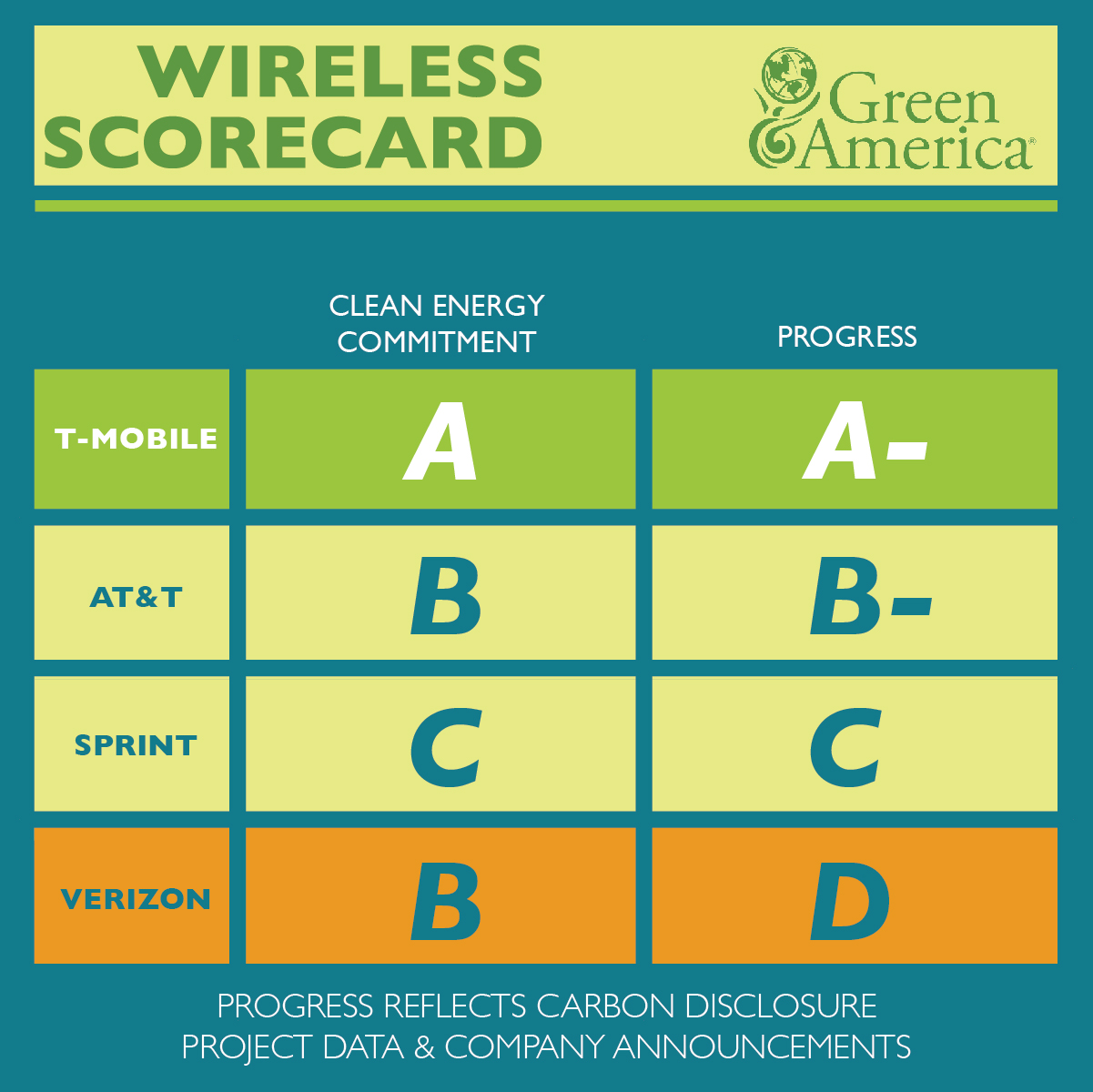
We estimate that previously, major telecoms used the equivalent of over seven coal plants of fossil fuels each year. These recent announcements would cut that nearly in half. The industry has advanced from almost zero clean energy when we launched our campaign to an average of 45 percent. But we know the effects of the climate crisis won’t be felt halfway, so solutions can’t stop halfway either.
We’re urging the entire industry to reach 100% clean energy before 2025.
|
|
2 Outstanding Environmentally Responsible Companies Honored in Closing Round of Prestigious Green Business Award |
WASHINGTON, D.C.—October 8, 2019— Small businesses in Philadelphia and the San Francisco area are being recognized by the national nonprofit Green America with $5000 awards for their exemplary commitment to a green economy. Green America’s People & Planet Award celebrates socially and environmentally responsible small businesses. The winners were Bennett Compost and Planted Table for the theme of “Best of the Green Economy.”
This was the final round of the award, which honored 62 small businesses over its eight-year run. The first round of the People & Planet Award was announced in the summer of 2012 with the theme of “Local Community Action.”
“For over a decade, the People & Planet Award has told the story of small green businesses in a powerful way – highlighting their innovation and deep commitment to people and the planet. Award winners have proven that business can be a force for social justice and environmental sustainability,” said Fran Teplitz, Green America’s executive co-director. “The award has also injected over $300,000 into the small, green business sector, helping local businesses take their next green steps.”
The winning companies:
- Bennett Compost (Philadelphia, PA). https://www.bennettcompost.com/. Bennett Compost composts the food waste and organics for over 3000 households and businesses in the Philadelphia area. According to the UN, over 30 percent of the food we grow winds up in landfills, contributing to over 8 percent of greenhouse gas emissions each year. Bennett Compost’s goal is to give Philadelphians the option to compost, even in the city! The average person throws out over 1600 pounds of "garbage" each year. Bennett Compost’s customers throw out half of that.
- Planted Table (San Francisco Bay Area, CA). https://plantedtable.com/. Planted Table was launched by two sisters who wanted to make a heart-healthy, organic plant-based diet more accessible to everyone. Planted Table is a vegan company that avoids wastefulness by using glass containers. By doing this, they have saved over 100,000 plastic containers from filling landfills and customers say Planted Table helps to greatly reduce their household waste. Planted Table also works with local farms for their organic produce.
“We are so grateful for this award and to everyone who voted for us. We will be using the $5,000 to expand our compost processing capacity so that we can continue to collect more organics from more Philadelphians. We not only want to keep this valuable material out of the waste stream but make sure its potential is fully utilized by turning it into a nutrient-rich soil amendment. Feed the soil, not the landfill!” said Jennifer Mastalerz, co-owner of Bennett Compost.
“Winning this award is a game changer for our business. It gives us some much-needed funds to invest in upgrading our kitchen equipment and allows us to purchase new, reusable glass containers, which will allow us to take on more meal plan members. Being able to offer our plant-based, sustainable meal delivery service to more people is a win for everyone. Thank you so much!” said Executive Chef and Co-Founder Lauren Mahlke and Co-Founder Megan Scott of Planted Table.
The People & Planet Award recognizes innovative U.S. small businesses that integrate environmental and social considerations into their strategies and operations. The winners were selected by the public during a month-long online voting period. The award has been made possible through a generous supporter, and 2019 marks the planned conclusion of the program.
The businesses that the public vote on are determined by public nominations and an expert panel of judges: Justin Conway, Calvert Impact Capital; Tess O’Brien, Clean Power Perks, Erlene Howard, Collective Resource, Inc., Dale Luckwitz, Happsy.com; Martin Wolf, Seventh Generation; and Beth Porter, Scott Kitson and Fran Teplitz of Green America.
ABOUT GREEN AMERICA
Green America is the nation's leading green economy organization. Founded in 1982, Green America provides the economic strategies, organizing power and practical tools for businesses and individuals to solve today's social and environmental problems. www.GreenAmerica.org and www.greenbusinessnetwork.org
|
|
8 Ways To Make Your Money Greener |
Teenage Swedish climate activist Greta Thunberg grabbed headlines in the U.S. last month when she traveled to the 2019 UN Climate Action Summit in a sailboat and then accused adults of having stolen her generation’s hopes and dreams with their inaction on climate change. But in her home country, Thunberg and her movement already seem to be having an effect on the habits of adults; domestic air travel is falling in Sweden as she’s become the face of a push to reduce air travel.
Even if you’re not ready to cut back on flying, there are other ways you can have a personal and positive impact on the environment. One of the most obvious is with your money—how you bank it, invest it, spend it and share it. Here are eight ways to make your money greener (or promote other causes you deem worthy).
1. Switch Banks
We get it. Switching banks is a hassle. In the most recent year studied, J.D. Power reports, only 4% of bank customers made a switch. More often, consumers simply add a bank when they want a new service and end up banking with more than one institution.
Still, if you’re ready to leave your bank or add a new one, it makes sense to include an institution’s environmental policies in your search criteria. That can mean either looking for banks that were created with a green or social mission, or checking out established banks’ environmental records.
A few organizations track banks that have embraced an environmental mission. For example, the website of Green America promotes banks and credit unions that have partnered with its efforts. If you’re in the New York and D.C. area, you’ll see Amalgamated Bank pop up. From D.C. to Virginia, there’s United Bank.
On the West Coast in California, there’s Pacific Premier Bank (it made our 2019 Best Banks In America list) and Neighborhood National Bank. In southern states like Alabama there’s the Bank of Vernon. Most of the banks are small or community banks, which means they may not offer all the services you want.
If you prefer bigger banks, consider checking out the ratings of JUST Capital–a not-for-profit that rates big public companies on a variety of corporate responsibility factors, including their environmental records and (full disclosure) partners with Forbes to produce the Just 100.
To save you time, we sorted the list of big banks based on their JUST environmental scores here; Citigroup took first followed by Wells Fargo and PNC Financial Services, which tied for second place on this list. You can also search JUST’s listings for banks that avoid working with oppressive governments or authorities and banks that excel in their treatment of workers, customers or communities.
Another option: Fintech startup Aspiration offers what it promotes as socially responsible banking services. Its cash management account, similar to checking, made our list of Best Cash Management Accounts of 2019. It also offers investment funds, the Redwood Fund and Redwood IRA, composed of companies committed to ethnic diversity, gender diversity, better ethics and addressing climate change. If you want to know more, read Forbes Advisor’s review of Aspiration.
Ready to switch? Check out How To Switch Banks In 5 Easy Steps. If you’re interested in communicating your social and environmental reasons for leaving to a bank and being part of an initiative, there are organizations such as Real Money Moves (Breaking Up Is Hard To Do) and Women Power Our Planet that offer guides on how to do that.
2. Make Your Current Bank Greener
If you don’t want to switch banks, there are ways—from going to paperless statements to pressuring your bank to behave better—to help the environment or other causes.
Going paperless saves banks money, which is, no doubt, a big part of the reason why they promote it so relentlessly. But it also reduces the number of trees that get logged and cuts down on the environmental impact of producing and delivering paper.
Doesn’t storing data suck up energy? Yep, that’s why Microsoft, #1 on the Just 100 for 2019, is working so hard to reduce energy use at its data centers. But your bank is going to keep your records online regardless. So unless you have a compelling reason for needing paper, you might as well go paperless. (As a bonus, some banks will even offer you rewards or discounts for saving them the cost of mailing you statements.)
Beyond going paperless, when your bank offers a product or service that is green and positively engages the local community, support it. Sure, these efforts might be in large part public relations. But if the response to a bank’s environmental efforts are positive, it is likely to do more. In other words, banks have feelings (okay, marketing departments), too.
Want to amp up the pressure on your bank? Besides listing banks it approves of, Green America’s finance page has calls to action to pressure certain banks to, for example, stop funding fossil fuel companies. If other issues concern you, look around. Example: Guns Down America rates banks on whether they make loans to the gun industry.
And don’t forget that the big banks are publicly traded. That means they respond to shareholders as well as customers and workers. In 2018, a group of Catholic nuns flexed their shareholder muscles and pushed Wells Fargo to publish a business standards report on its own shortcomings.
3. Get a Socially Responsible Credit or Debit Card
There are three ways to use your credit card to advance green and other causes you care about: using affinity credit cards; donating credit card reward points or cash back; and getting a card from a socially responsible bank.
Affinity credit cards are issued in partnership with a charitable organization. For example, Bank of America offers the Susan G. Komen Visa Signature credit card—0.08% of every purchase goes to the charity’s fight against breast cancer. The bank also donates an additional $3 every year the card is renewed. Plus, you get a pretty good deal: 1% to 3% cash back and no annual fee. BofA offers a similar card with the World Wildlife Fund as the beneficiary. And both cards are currently offering a $200 sign-up bonus. (Read: The Best Credit Card Sign-Up Bonuses.)
Meanwhile, some credit card issuers offer you the choice of directing the reward points or cash back you’ve earned to charities of your choice. Discover allows you to give to a list of charities that includes the American Red Cross, the American Society for the Prevention of Cruelty to Animals (ASPCA), Operation Homefront and the World Wildlife Fund. Mastercard has the Charity Charge World Mastercard credit card that donates 1% cash back on every purchase to any nonprofit or religious organization you want.
Affinity cards and donating rewards points help you support the cause of your choice, but these approaches don’t assure that the bank issuing the card meets your definition of socially responsible. If that is something that greatly concerns you, then head back to Green America and look at its list of socially responsible credit cards offered by the Independent Community Bankers of America, an organization that supports community banks.
4. Become A Socially Aware Investor
Whether you call it Socially Responsible Investing (SRI), Environmental Social & Governance (ESG) investing or Impact Investing, there are more options than ever for putting your investment dollars where your values are.
Choices in this area range from narrow impact investments, such as green bonds to support renewable energy; to baskets of theme (e.g.“fossil free”) stocks, such as those offered by Motif Investing; to broad-based managed mutual funds; to modified index funds that simply omit fossil fuel stocks. (Or weapons stocks or tobacco—or whatever.)
There are good financial (as opposed to ethical) arguments both for and against ESG investing. On the one hand, some investing pros think the impact of climate change on companies is being wildly underestimated and that just buying the market could be a mistake. (Read This Hedge Fund Superstar Thinks Climate Change Will Impact All Your Investments-And Soon.)
On the other hand, ESG investments tend to be less tested and more expensive— for example, the new Vanguard Global ESG Select Stock Fund (VEIGX) has an annual expense ratio of 0.55%, compared to just 0.14% for the Vanguard Total Stock Market Index Fund (VTSMX). (Read: We Want to Invest in ESG Funds, But Don’t. Here’s Why.)
Regardless, it’s usually smart to start small when investing in a new way, and fortunately, there are a growing number of apps and investing services that allow you to do just that.
For example, Stash, which allows customers to buy fractional shares of individual stocks and ETFs, highlights a clean energy ETF known as Clean & Green on its educational page. The ETF includes 30 renewable energy companies. Stash also lists a non-energy-focused portfolio that it describes as the Do The Right Thing ETF—actually the iShares MSCI USA ESG Select ETF.
Motif is another fractional buying service that allows users to create their own special interest baskets of stocks or buy into thematic portfolios created by others.
Robinhood and Acorns are two apps that offer clean energy portfolios along with socially responsible funds. The leading robo-advisors, such as Betterment, also offer socially responsible funds. If you’re looking for a robo-advisor that solely focuses on SRI, then check out Earthfolio.
When researching individual mutual funds, you can use a website like Fossil Free Funds. You type in the name of the fund or its ticker and it will give you a break down of how the fund does or does not contribute to carbon emissions. Plus, big mutual fund providers like Vanguard, Schwab and Fidelity, now provide information on funds that are socially responsible.
Don’t be surprised if your 401(k) doesn’t offer ESG fund choices—by one estimate fewer than 10% of plans do. (If you’re really determined, ask whether your plan offers a brokerage window, which lets you invest outside the normal menu of fund choices.)
5. Shop Socially Smart
When banking fintech Aspiration rolled out Aspiration Impact Measurement (AIM), it was a reminder that spending money can be socially responsible, too. The AIM tool allows customers to see the environmental and social effect they have on the planet based on the businesses they choose to shop at. Moreover, Aspiration’s debit card gives you a cash back bonus for shopping at businesses with high AIM scores.
Or you could take the what-not-to-buy approach. The Buycott app—available for both iPhones and Android phones—allows you to scan a bar code or a product’s QR code and then see if that product runs afoul of causes you care about. For an all around socially responsible shopping experience, an app called Better World Shopper (iOS) let’s you search for shops by name and see how your local haunts are graded. If they don’t score well, and you’re looking for new businesses to support, check out the B Corp listings—these are businesses that have committed themselves to a high standard of behavior.
Finally, there’s the cash-back-for-charity approach to buying. Amazon.com shoppers can take advantage of AmazonSmile, a philanthropy program where 0.5% of eligible purchases on Amazon go to a charity of your choice. Feeling extra generous? You can buy an item that a charity needs from Amazon’s charity list—and Amazon will still donate 0.5% of your purchase to the charity of your choice.
6. Book Travel With Responsible Companies
Various airlines, trains, hotels and cruise lines are all committing to reducing their carbon footprints. For help, check out this list of 50 Travel Companies Trying Their Hardest To Reduce Their Carbon Footprint. On it, you’ll find airlines like JetBlue and British Airways and food chains popular in airports, such as Starbucks, that have pledged to be more socially responsible. Some of the transportation systems on this list are not only trying to cut their own carbon footprints, but are also offsetting the current carbon emissions by funding projects that will help absorb carbon emissions.
7. Carpool
“You are not stuck in traffic, you are the traffic.” — RuPaul
Yep, this is a money issue, too, since carpooling will not only cut your individual carbon footprint but should also save you some bucks. Carpooling with coworkers, neighbors, and fellow soccer parents has always been a thing. But here too, apps are making it easier than ever to behave responsibly. Among the apps available for both Apple and Android users.
- GoCarma. A carpool program for coworkers and families with services in the U.S. and Europe. The app helps frequenters of the high-occupancy vehicle (HOV) or carpool lane receive discounts on tolls.
- Scoop. Here’s a carpool service that’s designed for coworkers who live near each other and neighbors who work in close proximity.
- Uber and Lyft. These ridesharing apps have carpool options that allow you to pay less than for solo rides.
- Waze Carpool. Waze is originally a GPS navigation app, but it entered the ridesharing industry and has differentiated itself in three ways. You carpool with anyone headed in your direction, but unlike Uber and Lyft, you get to choose who the driver is and who the group of carpoolers will be. The third way is that you get to split the cost of the ride with other riders. That makes carpooling with strangers more comfortable.
- Via. A low-cost, ride-sharing app for city-dwellers who don’t mind carpooling.
8. Donate
Individual giving to charity declined 1.1% in 2018 to $292 billion, and was down 3.4% when adjusted for inflation—a decline that is generally attributed to the December 2017 tax reform, which dramatically reduced the number of tax filers who can benefit from the charitable tax deduction. Still, environmental and animal organizations did comparatively well in 2018, with donations (including those from foundations and businesses) climbing 3.6% from 2017 to $12.70 billion. That’s an all-time high and a 1.2% increase when adjusted for inflation.
Here’s the good news: While it’s harder than ever to claim a tax deduction, it’s easier than ever to donate and to find organizations you care about. Major charities all take donations online. (You can see America’s Top 100 Charities, as measured by donations and sort them by their mission, here.)
In this area, too, apps can help you achieve your goals. Here are some options.
- Coin Up. A roundup app that takes your leftover change and gives it to a charity of your choice. You may not find the charity you want, but you may find others that could be just as worthy.
- ShareTheMeal. The United Nations World Food Programme created an app for people to help fight hunger across the world. You can give as little as $0.50, and it can feed one child for one day.
- WoofTrax’ Walk for a Dog. This app allows you to use your normal everyday dog walks to fundraise money for your local animal shelter.
- Donate a Photo by Johnson & Johnson. The queen and kings of Instagram selfies can donate their photos to the Johnson & Johnson app and then J&J will donate $1 per photo to the cause of your choice.
- Charity Miles. Active people can use their exercise routines for daily greater good. This app allows you to raise money from family and friends for the charity of your choice without committing to an event. You can raise money for charity as you reach physical milestones through walking, running or biking.
How do you know where an organization will use your charitable dollars efficiently? It can be difficult to determine on your own, although this advice in How To Check Out A Charity Before Giving can help.
Another option: The Better Business Bureau has created a list of 20 environmental and animal charities that meet its accountability standards. The charities on this list have a BBB Accredited Charity badge somewhere on their website to notify you that there’s an agency holding them accountable. BBB also has a library of guides on discerning where to give and how to be an informed donor. Other websites that can help you evaluate charities include Charity Navigator and Charity Watch.
Follow me on Twitter. Send me a secure tip.
 Asia Martin Asia Martin
Asia is a personal finance writer for the Money and Markets team at Forbes. She's based in New Jersey. Before joining Forbes, she reported for Financial Advisor magazine and also wrote for The Cranford Chronicle, NJ.Com and ThePopBreak.com. She also spent two years teaching English as another language in Shenzhen, Guangdong, China.
|
|
Artifex Financial Group |
Artifex Financial Group specializes in creating custom ESG portfolios that adhere to your specific preferences. Our results have proven that you can do well by doing good. Contact us today for a copy of our whitepaper or a free review of your portfolio.
|
|
Conte Wealth Advisors |
Chris specializes in Sustainable Investing (Socially Responsible Investing (SRI), Environmental, Social & Governance (ESG) and Impact Investing.) If you are unfamiliar with this approach, he would be glad to discuss it with you.
|
|
Scientific American |
|
|
Two Bettys Green Cleaning Service |
Our major areas of social and environmental impact are worker and environmental justice. We work hard and prioritize putting people first by how we treat them, providing them a living wage, and offering more than usual benefits (and more whenever possible), We know that a flexible schedule is best for people and families, thus we trust our employees to manage their time as they need, and it works for them and us. We invite all who can learn to clean to work with us. It's a skill anyone can learn, and is good, hard, honest work that we believe deserves a fair wage and great support.
It is also essential to our work to care for our earth by doing all in our power to use wise products, office practices, minimize our negative environmental impact, and educating our staff, clients, and local community on green practices. We also make a point to get political. We work with local groups of small businesses, regularly participate in town hall meetings, and visit out state's capitol about both issues. |
|
Celebrating Latinx Heritage Month |
Latinx Heritage Month—also recognized as Hispanic Heritage Month—began as a week-long celebration of the heritages and cultures of citizens of Hispanic origin in the United States. Since its creation in 1968 by President Lyndon B. Johnson, the celebration has expanded to encompass 30 days from September 15th to October 15th. Mid-September marks the beginning of Latinx Heritage Month because it is the anniversary of independence for five Latin American countries: Costa Rica, El Salvador, Guatemala, Honduras, and Nicaragua. Mexico, Chile, and Belize celebrate their independence days within this period and Día de la Raza occurs on October 12th.
The term “Latinx” refers to people of Latin American origin or descent as a gender-neutral alternative to Latino or Latina. In comparison, Hispanic is associated with the Spanish colonialization of the Americas, thus excluding non-Spanish speakers that share geographic and historical heritage with Spanish speakers. The term “Latinx” is inclusive of indigenous, Brazilian, and other non-Spanish speaking groups that take part in the celebration.
As the United States’ largest minority, Latinx people offer an extremely diverse and culturally rich influence on our country. Cultural contributions like music, food, language, and beliefs have shaped the nation over the decades. Additionally, Latinx-owned small businesses have seen recent success: the average annual revenue jumped an impressive 26.5 percent in 2018. These small businesses contribute more than $700 billion to the economy annually, according to the US Hispanic Chamber of Commerce, and have grown 31.6 percent since 2012—that's double the rate of all businesses across America.
Shop Green Businesses for Latinx Heritage Month
The Green Business Network at Green America is proud to stand with Latinx-owned green businesses as an expanding and driving force in the green economy. We support businesses that adopt practices to protect people and the planet through goals of social and environmental justice, sustainability, and community health and development. Join us in supporting impactful, eco-minded Latinx entrepreneurs around the nation. Syracuse Cultural Workers offers a great example of products commemorating Latinx Heritage Month.
Browse our certified minority-owned green business members in our online directory, GreenPages.org.
|
|
Socially Responsible Investing Retirement Guide |
|
|
Big Banks to Stop Future Financing of Prisons & Immigrant Detention Centers |
Green America’s mission is to build the green economy, one grounded in social justice and environmental sustainability. To do so, we promote responsible, sustainable economic actions, from supporting green businesses to helping individuals bank and invest with financial institutions that support people and the planet.
This summer, Green America joined a coalitional letter to five regional banks – Regions Financial Corporation, Citizens Financial Group, Pinnacle Financial Partners, First Tennessee Partners, and Synovus Bank – urging them to conduct human rights due diligence in relation to their financial ties to private prisons and immigrant detention centers. The letter came on the heels of eight major banks agreeing that they will not issue new loans to the private prison sector. In response to wide-spread pressure, Wells Fargo, Bank of America, SunTrust, JPMorgan Chase, BNP Paribas, Fifth Third Bancorp, Barclays Bank, and U.S. Bancorp all announced this year that they will be ending financing of prisons, specifically CoreCivic and GEO Group, the two largest U.S. private prison and immigrant detention companies.
Companies Profit from Prison & Detention Centers
GEO Group and CoreCivic, the largest private incarceration corporations involved in detention centers and immigration facilities, are contracted by US Immigration and Customs Enforcement (ICE), the Federal Bureau of Prisons, and the US Marshals Service. While private prison companies make up about 10% of federal and state prisons, almost two-thirds of people detained by ICE are held in privately-funded facilities (mostly CoreCivic and the GEO Group).
These companies receive substantial profit from detention as the number of detainees increases. In order for them to maximize profits and decrease costs, they have even removed basic human needs, like access to soap and other hygiene products, while maximizing the number of asylum seekers in already overcrowded facilities. As an August 2019 report from the Center for American Progress documents, “In memos to their shareholders, both companies [GEO Group and CoreCivi] acknowledge that policies with the potential to reduce the U.S. detainee population constitute potential risk factors to their business model.”
In addition to over-crowding, the lack of basic needs, and family separation, there are a growing number of reports of other inhumane and cruel conditions, some of which are violations of the Human, Civil, and Political rights as outlined by the United Nations. There is now a class action lawsuit filed on behalf of 55,000 people in ICE detention centers, alleging severe mistreatment. Already, twenty-four people have died in ICE facilities since Donald Trump became president.
How are Banks Involved?
Detention centers where asylum seekers and immigrants continue to be mistreated have largely been financed by major banks. These banks, and smaller ones, therefore have shared complicity in the human crisis that continues to unfold due to the banking and financial services they provided, totaling $2.6 billion in lines of credit and loans, to CoreCivic and the GEO Group. In return, banks have received millions of dollars in fees and interest. Some of these centers also benefit from the labor of prisoners and detainees who receive little to no benefits for their work.
Banks Change Policy, An Important First Step
As noted above, in response to organized campaigns, public outcry, and banks’ risk own assessments, more and more financial institutions are moving away from doing business with for-profit prisons and detention centers. These changes are certainly important steps. It is also important to understand that this “divestment” refers to future financing and banks will continue to fulfill commitments already underway for years to come and are still maintaining their holdings (stocks and bonds) in for-profit prisons.
Vote with Your Dollar
Many concerned investors and activists who want to see an end to ICE detention centers and for-profit prisons have taken action, such as protesting outside the branches of big bank and through social media.
Another way to take action is to use Green America’s resources to Get a Better Bank. Yes – there are banks and credit unions focused on community development that do not support for-profit prisons and detention centers. Vote with your dollar today and switch to a bank that supports people and the planet.
For more information on divestment from for-profit prisons and fossil fuels click here.
Individually and collectively, our economic actions make a difference every day and can bring us closer to the kind of world we need in which all communities are healthy and safe.
|
|
Green America Applauds T-Mobile, AT&T, and Sprint for Major New Advances on Renewable Energy |
Washington DC// September 26, 2019: In one short week, three leading U.S. telecommunications companies – T-Mobile, AT&T, and Sprint – have all announced major contracts to increase their use of renewable energy. Green America, which launched the “Hang Up on Fossil Fuels” campaign in 2017, applauded the companies’ responsiveness to consumer demand for more green energy. Green America is currently focusing its campaign on Verizon, which made a commitment to 50 percent renewables by 2025, but has so far not entered into new contracts for clean energy.
“Telecom companies are listening to their customers,” said Todd Larsen, Green America’s Executive Co-Director for Consumer and Corporate Engagement. “Since the start of the Hang Up on Fossil Fuels campaign, tens of thousands of consumers have written to and called telecoms, urging them to move to clean energy. The industry is taking important steps on clean energy, and now needs to accelerate the move to 100 percent wind and solar.”
Here are the major new announcements:
- T-Mobile said that the company will be adding one new wind farm and four new solar farms that will provide a total 600MW of green energy. When online, the company reports these renewable energy sources will bring T- Mobile to 95 percent of its RE100 commitment of 100 percent clean energy by 2021.
- A week ago, Sprint announced its first clean energy project, a 12-year virtual power purchase agreement (VPPA) with Duke Energy Renewables that the company states would provide about 30 percent of the telecom’s energy.
- On September 23, AT&T announced two new renewable energy deals with Invergy and Duke that will bring the company to over 1.5 gigawatts of clean energy. AT&T estimates that the total annual clean energy produced under the company’s existing contracts is equal to taking 690,000 cars off the road for one year.
Verizon did not announce any new contracts. Last year the company announced a commitment to 50 percent renewable energy by 2025 and issued a $1 billion green bond this year to fund a variety of green initiatives, including renewable energy.
“Green America applauds T-Mobile’s industry-leading progress on renewable energy,” said Beth Porter, Green America’s Climate Campaigns Director. “In order for telecoms to address the climate crisis, we need the entire industry to move to 100 percent renewable energy by 2025 at the latest. With wind and solar power increasingly costing less than fossil fuels, it also makes economic sense for companies to rapidly adopt clean energy.”
Green America’s Hang Up on Fossil Fuels Campaign is pressuring the telecom sector to use 100 percent renewable energy since 2017, when the industry was using almost no clean energy.
ABOUT GREEN AMERICA
Green America is the nation’s leading green economy organization. Founded in 1982, Green America provides the economic strategies, organizing power and practical tools for businesses and individuals to solve today’s social and environmental problems. http://www.GreenAmerica.org
Contact: Todd Larsen, Green America, tlarsen@greenamerica.org or 202-872-5310
|
|
Herban Beautanicals |
Minimizing waste, streamlining supply to reduce shipping impact of raw materials, sustainable-, ethical-, and environmentally- conscious raw materials & supplies sourcing. Carbon-footprint reduction. |
|
Delilah Home LLC |
We provide a natural, sustainable, and safer home textile option for your everyday use. Our 100% organic cotton and hemp products pay homage to our environment and enhance the lives of customers. We believe, what you put on your body is just as important as what you put in your body. Our Delilah Home textiles do not contain allergenic, cariogenic or toxic chemicals and may also help reduce allergies and respiratory problems. Plus organic cotton has been known to feel better, last longer and have stronger fibers. Organically grown and processed cotton and hemp will not expose you to herbicides, fungicides or other chemical residues. Live cleaner with Delilah Home.
|
|
Anika Harden |
|
|
Sprint makes first major commitment to clean energy |
Sprint announced its first major commitment to clean energy with a virtual power purchasing agreement with Duke Renewables for a 182 MW wind farm. The deal will result in Sprint using 30% renewable energy.
In Green America's Clean Energy Calling Report Sprint was in last place amongst the four major telecoms -- AT&T, Verizon, T-Mobile, and Sprint -- for its commitments to renewable energy targets and renewable energy purchases. Both were near zero.
Sprint's announcement with Duke Renewables marks an important step forward for the company and it part of an overall shift to renewable energy by the sector.
Since Green America launched its Hang Up On Fossil Fuels campaign in 2017, the telecom sector has gone from using almost new renewable energy to major commitments and/or purchases from each of the major carriers.
|
|
AT&T Reaches 1.5 Gigawatts of Clean Energy |
AT&T announced new contracts for solar and wind energy that will bring its total clean energy purchases to over 1.5 Gigawatts. Last year the company announced 820 MW of clean energy, so the new announcement nearly doubles AT&T's commitments.
AT&T estimates that with these new clean energy purchases are the equivalent of providing electricity for more than 560,000 homes or taking 690,000 cars off the road for 1 year.
The new purchases mean that AT&T will be using over 50% renewables to meet its energy needs, and makes AT&T once of the largest corporate purchasers of clean energy in the US.
When Green America started its Hang Up on Fossil Fuels campaign in 2017, AT&T was using less than 2% clean energy. Thanks to everyone who took action with us -- AT&T heard you.
Now, we need AT&T to go to 100% renewables by 2025.
|
|
A Step Towards Combatting Child Labor in Cocoa |
The Ivory Coast and Ghana are the top producers of cocoa globally. Cocoa farms in both countries are plagued by child labor, with an estimated two million children working in cocoa fields. These are not children helping on the family farm part-time. These are children who are working full time, day after day, in the fields. Some of them are doing dangerous work, and some are trafficked from other countries and are forced to work for little or no money.
Progress on Child Labor in the Cocoa Industry
Despite numerous commitments from US corporations over the past 20 years, little progress has been made in addressing child labor in the cocoa sector, meaning that child labor is still being used (and profited off of) to make many of the chocolate brands that Americans regularly buy like Godiva, Hershey, Nestle, and Mars. Though, not all companies are the same, some have made progress, others (like Godiva) have made very little progress. Take a look at our scorecard to see how corporations hold up!
But, while corporate efforts have resulted in little improvement, the Ivory Coast and Ghana have recently taken one step towards improving the sector. Both governments have announced that they will raise the floor price for cocoa farmers and levy an extra fee to cocoa buyers. This move will raise the price of cocoa by $400 per ton. While this is a welcome and important move, unfortunately more needs to be done to truly eliminate child labor and poverty in the cocoa sector. Compensation to farmers still remains well below a living income. The government policies will create a minimum compensation to farmers of $1,820 per ton. But research from Fair Trade International indicates that a living income is closer to $2,668 per ton for Côte d’Ivoire, and $2,301 per ton for Ghana, and those estimates may still be on the low end.
The VOICE Network, of which Green America is a member, is a coalition of civil society organizations and trade unions, working to address blind spots and underrepresented issues in the cocoa value chain from consumer to farmer. Earlier this month, the VOICE Network published a brief analyzing both the floor price adjustment and other necessary steps in order to make cocoa a more sustainable industry. Some of the necessary changes laid out in the paper include:
- an even higher floor price, as the current increase is still too low for farmers to make a living income;
- ensuring that the money goes to farmers, rather than being subsumed by an intermediary;
- developing reforms that provide protections for both farmers and the forests, so that further deforestation does not occur;
- address human rights and child labor together, through women’s economic empowerment, access to education, providing proper documentation to individuals, such as birth certifications, and community-based development;
- and the need for more countries to make similar commitments, such as other cocoa producing nations like Indonesia, Brazil, Ecuador, Nigeria, and Cameroon.
To see the rest of the recommendations, check out the VOICE Network’s paper here. Several corporations issued statements following the price floor increase announcement, Green America’s ally and VOICE Network member, Mighty Earth, compiled the responses here.
Interestingly, Godiva, which Green America has an active campaign against, stated that “GODIVA supports any efforts to lift cocoa growing communities in the Cote d’Ivoire and Ghana out of poverty, and protect the future of cocoa farming and farmers.” This is great news! But let’s see if they will put their money where their mouth is… Something that would support these efforts would be for Godiva to shared who certifies its cocoa; share any plans, progress, or metrics about the amount of certified cocoa in its supply chain; and to publicly announced any programs that go beyond certification and better support farmers.
Without this information, you and other consumers have no way of knowing if Godiva is actually doing anything substantive to help address child labor and improve the conditions for cocoa farmers. As of now, all we are able to discern is that Godiva is behind a number of its peers and has a good public relations team… If you haven’t already, call on Godiva to do more and provide greater transparency!
Chocolate without Child Labor
When purchasing chocolate, one of the best ways to support cocoa farmers and encourage corporations to take action against child labor, is to buy chocolate from companies that are trying to reshape the way cocoa is purchased, like Divine, Alter Eco, Equal Exchange, Endangered Species, Shaman, or Theo Chocolate – all of which have received an A rating on our scorecard.
|
|
Smog Armor LLC |
Smog Armor Paint Benefits:
1. Non-toxic
2. Zero-VOCs
3. Made in USA
4. Materials sourced in USA
5. no animal cruelty
6. The paint eliminates surrounding air pollution including CO2, VOCs, and NOX
7. Uses 100% recycled paint cans
8. Have a recycle program, customers can send back unused paint that is donated to community anti-air pollution murals in our communities to improve the air we breathe
9. Recycle program to receive paint cans back that will be washed and reused to eliminate plastic waste or the need to recycle the cans
|
|
Amazon commits to 80% and 100% renewable energy |
After years of pressure by Green America, Amazon announced it will get to 80% renewables by 2024 and 100% by 2030.
Our demands have always been: Commit to 100% renewable energy by 2020 and end the construction of any new data centers that rely on fossil fuel or nuclear power.
Amazon was using 0% renewable energy back in 2014 when we started our Amazon: Build a Cleaner and Fairer Cloud campaign. Since then, Amazon has contracted four wind and solar farms worldwide providing over 50% of its energy use.
But 50% is not good enough when other tech giants are already at 100% clean energy. That's why we need to keep the pressure on Amazon to reach 100% clean energy by 2020.
Many thanks to all of you who have taken action with us, and keep up the pressure.
|
|
Clean Up Wireless & Create Green Jobs |
By Ayate Temsamani, Climate Fellow
The Impact of Telecoms
The US telecom industry uses vast amounts of energy, with the major four companies collectively using over 30 million megawatt hours (MWH) of electric power every year—enough energy to power all the households in New York City.
This has mostly come from dirty energy sources, emitting 20 million tons of CO2 every year. That's why our Hang Up on Fossil Fuels campaign urges telecom companies do better. Currently, T-Mobile is the only telecom to set a 100% target, and it aims to meet that by 2021. That's why we've been putting pressure on AT&T and Verizon to meet T-Mobile's commitment.
Investing in clean energy would curb greenhouse gas emissions and fossil fuel use that impacts the climate. And it would help to boost the US economy through the creation of green jobs.
Today, the world faces significant challenges: increasing shortages of raw materials, a steady rise in fossil fuel prices, and the effects of climate change already impacting communities and ecosystems globally. Countries are increasingly understanding that the fight against climate change and the efficient use of natural resources are critical. But the necessary changes also offer great opportunities for developing a more just and sustainable economy.
Opportunities for Green Jobs
Renewable energy has a large role to play in the transition to a low-carbon economy with better quality jobs. The renewable energy sector requires a multitude of skills to meet its manufacturing, engineering, installation, maintenance, and marketing needs across the country. People with various levels of qualification are benefited by the green jobs created through a clean energy transition.
Companies have also started to invest in special training and certifications to equip people with dynamic and agile skills to increase their chances to get a job. In fact, wind power technician is one of the fastest-growing jobs in the US, and AT&T has already announced plans to support students to develop new skills that match the needs of the renewable energy industry, through the AT&T Wind Energy Scholarship fund for the Texas State Technical College (TSTC).
Several million people nationwide are already working in green jobs. The Solar industry alone has created more than 350,000 jobs for Americans with major job growth projections in the future. In 2018, AT&T announced its acquisition of 830 MW of wind power, taking AT&T up to 30% clean energy and cutting more than 2.6 million tons of CO2 emissions. AT&T’s investment in wind power would create an estimated 1,000 construction jobs in Texas and Oklahoma and generate millions in property tax for local communities.
Investing in renewable energy delivers better quality and higher paid jobs. Landing a job in the renewable energy industry can lead to an 8-19% increase in income. Clean energy can also be installed in poorer, rural areas and thus boost economic activity, including in coal-dependent communities. According to Forbes, “wind will be cost-competitive and offer employment opportunities across the country’s second and third largest coal-producing regions, the Appalachian and Illinois Basins, by 2025.” The telecom industry can and should be part of this positive shift and provide a significant boost to the economy.
Tell Verizon to Take Action
After months of our campaign urging Verizon to commit to 100% renewable energy, the company released a commitment to reach 50% clean energy by 2025. This commitment would mean a reduction of 2.6 million tons of carbon dioxide, or the equivalent of taking nearly 600,000 cars off the road each year. This is a great step in the right direction, but the climate impacts won't be felt halfway - so action and solutions can't be made halfway. Verizon uses 12.6 million MWh each year, so if it moves rapidly to 100% clean energy, the climate and jobs impacts would be enormous. That's why we're calling on Verizon to set a 100% commitment to clean energy by 2025.
|
|
Anheuser-Busch |
Anheuser-Busch initiative aims to help farmers transition to organic, boost organic industry
By Ken Roseboro, The Organic and Non-GMO Report
Anheuser-Busch Company’s “Contract for Change” will provide long-term contracts to farmers, pay premium prices for transitional and organic crops
Can a major beer brand help increase organic farming acres in the United States? That’s the aim of a new initiative by brewing giant Anheuser-Busch to support the growth of the company’s Michelob ULTRA Pure Gold, the first national beer brand in the U.S. to be certified organic. Anheuser-Busch’s “Contract for Change” aims to help farmers through the three-year transition period to organic by providing long-term contracts and paying premium prices for transitional and organic crops, while helping grow the organic industry.
Addresses challenges of increasing organic grain production
Anheuser-Busch is well-positioned to launch such an initiative, according to Jess Newman, the company’s director of U.S. agronomy.
“We are highly vertically integrated into agriculture,” she says. “We breed our own barley varieties, we direct contract our own seed, and bring it into our own seed facilities. We own grain elevators in three different states and malt plants in two states, and we brew our own beer and take it to consumers. It’s a complete ‘seed to sip’ process.”
Anheuser-Busch works with 1,000 U.S. farmers who grow barley, rice, and hops for the company’s products.
The Contract for Change aims to increase production of organic barley used to make Michelob ULTRA Pure Gold, which is the sixth-fastest-growing beer brand in the U.S. with sales increasing by 200 percent since last year. A popular television commercial at the 2019 Super Bowl featuring actress Zoe Kravitz increased awareness of the brand.
To develop the Contract for Change, Anheuser-Busch sought advice from the Sustainable Food Lab (SFL), a non-profit organization that helps organizations implement innovations in sustainability in food production. Anheuser-Busch is an SLF member.
Elizabeth Reaves, SFL’s senior program director of agriculture & environment, said Anheuser-Busch has been innovative in supporting crop diversification and income diversification for farmers through direct contracting.
“They understand they can play a role by providing a market for some alternative crops,” she says.
Reaves says SFL shared findings of a recent report, US Organic Grain—How to Keep it Growing, that identified key challenges to helping farmers transition to organic.
One of the main challenges is the uncertainty that farmers will have a market for their crops through the transition to organic.
Newman says Anheuser-Busch can provide that assurance because of the long-term relationships they have with their contract farmers.
“It was a no-brainer to say; we’ll find a contract for four to six years, however long it takes to get transitioned. Our commitment is to buy any of the barley in that time period.”
Anheuser-Busch will pay a premium price for both the farmers’ transitional and organic crops.
They will also help farmers find markets for other crops grown in rotation with organic barley, including sugar beets, potatoes, and alfalfa.
“While we can’t buy all the rotation crops, we can help connect our growers to partners or other potential buyers. We’re working across the industry to try and forge those relationships,” Newman says.
Another challenge facing transitioning farmers is having access to crop advisors who can provide technical assistance about organic production. Anheuser-Busch’s staff of 15 agronomists can help provide that expertise. They will also work with the University of Idaho extension, which also has organic crop knowledge.
“Give barley growers an opportunity to try organic”
Anheuser-Busch will launch a pilot program for the organic transition in Idaho, one of the company’s main barley-growing states along with Minnesota, North Dakota, and Montana. The company also has a malt plant for organic barley in Idaho.
Newman says there is a lot of interest among farmers for the Contract for Change. “We see demand from growers who want to understand how organic can add value on their farm, help diversify it, and give them more choice. The whole point of the contract is to take a grower who’s never grown organic before and give them that opportunity.”
Dan Lakey, owner of Lakey Farms in Soda Springs, Idaho, is participating in the Contract for Change. He is growing 115 acres of transitional organic barley on his family’s 7500-acre farm.
“We are always looking for new opportunities on our farm,” Lakey says. “For several years we have been using less chemicals and fertilizers, and we are curious to see if our farm can grow organic crops.”
Lakey has been using regenerative farming methods that build soil health such as minimal tillage, cover crops, and diverse crop rotations.
“I want to do better than being sustainable. I want to regenerate the land I got,” he says.
Lakey says the Contract for Change could inspire other barley farmers to transition to organic.
“It may allow some current barley growers, who are hesitant about changing, an opportunity to try organic with a promise that they will have a buyer for their crops.”
Newman credits the Sustainable Food Lab as an advisor and facilitator in working to solve organic transition challenges.
“We stand on the shoulders of many wonderful companies that have worked hard to figure out how you can solve these gaps,” she says.
Reaves says Anheuser Busch’s Contract for Change can benefit both organic and conventional farming.
“There’s a big opportunity for them to build a partnership around soil, water, and the learning that can be generated between organic and conventional systems. There’s a lot of good exchange can come from both.”
Anheuser-Busch is the latest large company to launch an initiative to help farmers transition to organic production. Other companies that have launched similar initiatives include General Mills, Ardent Mills, Costco, Bunge North America, and The Andersons.
Newman thinks the Contract for Change can help the organic industry as a whole.
“I think it’s exciting to see a big company and a fast-growing brand being excited about supporting the industry as a whole. I think it will help shine a light on the good work that the organic industry is already doing.”
|
|
hatched llc |
We support our local economy by offering well paid work to teens, as well as working parents. We work hard to maintain a brick and mortar shop, to enhance our main street and to offer sustainable/ethical goods to our community.
As a retailer of apparel, we are very aware of the negative environmental and social impacts of traditional farming and manufacturing methods. For this reason, we only sell certified organic clothing and work with companies with and high awareness, and or certification of social accountability (such as SA 8000).
We are first and foremost concerned with offering goods that are healthy for children to wear and to play with and that are produced with respect of our Planet.
Our goal for the next year+ is to become 100% biodegradable, eliminating any synthetic materials from our shelves. We are currently at about 90%f not more. We are encouraging vendors to stop sending us items wrapped or bagged in plastic, and helping them to find biodegradable alternatives if they are not aware of them. |
|
hatched llc |
We support our local economy by offering well paid work to teens, as well as working parents. We work hard to maintain a brick and mortar shop, to enhance our main street and to offer sustainable/ethical goods to our community.
As a retailer of apparel, we are very aware of the negative environmental and social impacts of traditional farming and manufacturing methods. For this reason, we only sell certified organic clothing and work with companies with and high awareness, and or certification of social accountability (such as SA 8000).
We are first and foremost concerned with offering goods that are healthy for children to wear and to play with and that are produced with respect of our Planet.
Our goal for the next year+ is to become 100% biodegradable, eliminating any synthetic materials from our shelves. We are currently at about 90%f not more. We are encouraging vendors to stop sending us items wrapped or bagged in plastic, and helping them to find biodegradable alternatives if they are not aware of them. |
|
Pollinator Home Sites Available in Illinois |
Attention all pollinators! Prime real estate is now available just eight miles west of Chicago in suburban River Forest, Illinois. Enjoy native gardens on your way to work by visiting one of the 36 Parkway for Pollinators Gardens. Your kids can enjoy pollinator gardens at school and more gardens are located along the main corridor, Lake Street. Also, make sure to visit the 18,000 square feet of native plantings in the parks. River Forest is also a Tree City USA and close to the Des Plaines River for additional ecosystem support. For more information contact your listing agent, the River Forest Sustainability Commission. New pollinator properties added weekly during the summer!
Seriously, River Forest is a great place for pollinators. With 27,000 square feet of native gardens (excluding private gardens), River Forest is committed to helping pollinators thrive. The River Forest Sustainability Commission created the Parkways for Pollinators initiative to meet the need for pollinator habitats. We partnered with a local nonprofit with expertise in organic gardening and native plants, the Deep Roots Project.
The program’s purpose is three-fold: support pollinators, educate residents about native plants and pollinators, and ask residents to pledge to the Healthy Lawn, Healthy Family campaign. This campaign asks resident to pledge not to use synthetic chemicals on their lawns and gardens and implement sustainable lawn care practices.
Of course we want everyone to have fun while learning, so garden education and planting are offered at our popular Green Block Parties. By utilizing this already successful program that has been running for the past seven years, we offer residents a new activity: planting a native garden on their block’s parkway for everyone to enjoy. We’re replacing grass with plants with a purpose.
We couldn’t do this on our own. These gardens are free to all Green Block Parties with grant support from our local sustainability planning project PlanItGreen and the ComEd Green Region Grant Program in partnership with Openlands, a metropolitan conservation organization.
Our project leader and expert, the Deep Roots Project, meets with the resident in charge of the block party—ahead of time—to select an appropriate site. The 4’ x 10’ site is prepared before the party so that children and adults can participate in the fun hands-on planting activity and learn about native flowers that attract butterflies, humming birds, and other pollinators on the block.
The gardens are maintained the first year by Deep Roots—residents can contact the Deep Roots or the Commission at anytime with questions about their garden. In its first year, the Parkways for Pollinators Gardens initiative was incredibly successful, installing 15 gardens on parkways throughout River Forest; this year, 20 more gardens were added. The program will continue into the summer of 2020.
The Commission has been encouraging native plantings through working with Park District, Village of River Forest Public Works, and residents. We encourage residents to plant natives for their deep root structure to support healthy soils with the added benefit of supporting pollinators. We are thrilled to work with Green America’s Climate Victory Gardening program, and have mapped over 27,000 square feet of gardens fighting climate change and providing important habitat. So if you see a pollinator let them know, River Forest has space for them!
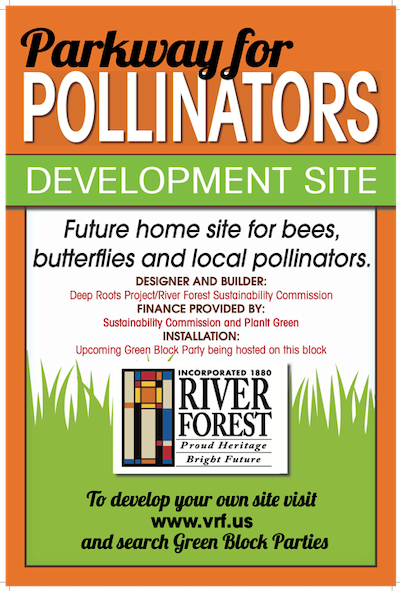
Read more inspiring Climate Victory Garden stories and tips.
|
|
WireWorx |
Wireworx works closely with a group of highly skilled artisans in South Africa and Zimbabwe to create a unique and beautiful range of fair trade beaded wire animals. This includes beaded animal figurines in a wide range of sizes, beaded trophy heads, beaded animal key chains, magnets, tree ornaments, wall and garden decor. We retail and wholesale worldwide and accept custom and corporate orders. |
|
Decoding a Corporate Response: The Carter’s Edition |
Today, we break down some responses that members and Green America received from Carter’s. Thanks to the over 6,000 people who’ve taken action with us to send Carter’s a message asking them to reveal the toxins in their supply chain and address them to protect workers and consumers.
Carter's Statement #1
“Thank you for your concern about Carter’s social responsibility efforts. Carter’s is committed to operating with the highest legal and ethical standards, including in the manufacturing of our products in foreign countries.”
Carter’s doesn’t define, either in its statement or on its websites, what the “highest legal and ethical” standards are. On its own, this phrase is meaningless – highest by who’s definition? Additionally, if they were operating at the highest ethical standard, we wouldn’t have needed to reach out to them for information about their corporate social responsibility (CSR) efforts – it would be publicly available!
A comparison between Carter’s and Target, which is a leader amongst larger retailers in addressing toxins and providing transparency, is instructive. Carter’s provides a single vague page of information on its website regarding all its social responsibility. By contrast, Target provides pages of information on its website (starting here), and publishes a detailed corporate social responsibility report, which makes clear the extensive work the company is doing to address issues like toxins, water issues, and the use of more environmental sustainable materials.
“To that end, Carter’s has established and implemented a social responsibility program that sets forth the standards, obligations, and requirements that foreign vendors must meet in order to do business with Carter’s. These standards are in line with, and in many cases exceed, all local country and international legal requirements and best practices, such as those set forth by the International Labour Organization, or ILO.”
Carter’s says its social responsibility program standards “are in line with, and in many cases, exceed all country and international legal requirements, such as those set forth by the ILO”. Since Carter’s also does not have a publicly available supplier list, we don’t know which country laws they are referring to; it is important to note that labor laws are often weak or poorly enforced in sourcing countries.
Current “obligations and requirements” often fall far short of prioritizing workers’ health and rights, thus the need for clear and measurable social responsibility efforts. The lack of legal requirements that protect workers and consumers is why organizations like Green America are holding corporations accountable – the current obligations and requirements fall woefully short of what is needed.
Finally, the ILO, as its name suggests, focuses on labor rights – so its standards do not necessarily address the environmental aspects of supply chains. Without more information, this statement rings of empty platitudes rather than concrete information.
“We review our social responsibility program on an ongoing basis, and to assist in implementing it, we partner with a leading third-party social responsibility firm to evaluate our vendors and conduct audits, both announced and unannounced. In addition, Carter’s utilizes its own internal sourcing team and the social responsibility staff of our sourcing agents to help educate our vendors on, and ensure they are meeting, our social responsibility standards.”
Once again, Carter’s doesn’t direct consumers to any tangible information about standards, how their vendors perform, and what – if anything – it does to address non-compliance with standards, including standards around toxic chemicals. When suppliers are non-compliant, does Carter’s work with the factory to improve environmental and working conditions? Or does it cut and run, potentially leaving workers without a job?
Additionally, time and time again, in numerous industries, third-party social audits do not detect labor abuses and are at best a partial solution to abuses in supply chains. And, auditors may not be trained in identifying toxins in the workplace, and whether workers have adequate protections.
Here, Carter’s offers that they ‘help educate vendors’ in order to meet their standards, however Carter’s does not state if they are actually paying enough for their products so that the vendor can implement international standards without going bankrupt. While education can be useful, it cannot occur alone and is far from a solution to labor abuses in supply chains.
“Carter’s is committed to operating under the highest legal and ethical standards of social responsibility- and we will only work with those vendors who are similarly committed.”
It’s good that Carter’s is “committed” to the highest legal and ethical standards, however what steps are they taking to turn commitment into action? Also, highest standards according to whom? And, how do these standards relate to the use of and disclosure of toxins in their supply chain? From this response, that all remains unclear.
Carter's Statement #2 – made directly to Green America
Before Green America asks the public to urge a company to improve its practices, we always reach out to the company to see if they can provide us with any information beyond what they publicly disclose, and to see if they will work with us to improve their practices without our launching a public campaign. After numerous efforts to reach out to Carter’s, this is the reply we received back from them:
“Thank you for contacting us. We have an internal restricted chemicals list that we are working on expanding. We are also actively assessing how we can better disclose this and other environmental, social, and governance-related information to our customers and the general public.”
Carter’s says it has an internal restricted chemicals list (RSL), which is a list of chemicals that the company uses to determine which chemicals can be found on its clothing when it reaches the consumer market. An internal RSL means that consumers don’t know what chemicals Carter’s allows on its clothing, and the company’s comment about “working on expanding” indicates that it is not as comprehensive as it could or should be. Furthermore, the message does not mention a manufacturing restricted substances list (MRSL), which restricts and bans what chemicals can be used in the manufacturing process. An MRSL helps protect workers and their communities from toxic chemicals.
The assurance of figuring out how to “better disclose this and other environmental, social, and governance-related information to our customers” sounds nice, but it does not indicate a timeline for when they hope to accomplish this by – a promise with unclear intentions of follow-through. Carter’s is also not committing to issue a full corporate social responsibility report that meet Global Reporting Initiative standards, which are the standards that responsible companies adhere to in their reports.
Further, there are many examples of how other companies disclose this information to consumers; this is not rocket science, rather Carter’s is denying consumers the ability to make a fully informed decision about which clothes you buy for your children. If you are interested in seeing how other companies display this information, see Target’s CSR page on chemicals. Target provides clear deadlines to implementing the RSL and MRSL lists throughout their value chain and even provides their current RSL list.
__
You, as a consumer, play a vital role in changing industry norms. Reaching out to companies to inquire about their policies and practices, demonstrates to a company that you care and that you will use your purchasing power to advance a more ethical and sustainable clothing industry. Consumers deserve to know what chemicals their children and the workers that make those clothes are exposed to. A company that has specific policies in place is likely to either share the information with you or direct you somewhere where you can learn more about what the company is doing. If a company offers you grand statements and few details, it probably isn’t as sustainable or socially responsible as the statement sounds.
|
|
Growing Hope Gardens Help the Homeless |
Written by Trina Calderón, a Los Angeles TV/filmmaker, journalist, and UC Master Gardener. She contributes art and culture writing to a variety of print and digital media, and writes short stories, essays, and screenplays. Committed to a creative journey as a storyteller aware of her strong female and Latinx perspective, Trina aims to add a voice where mainstream media does not.
Based in Los Angeles, California, Growing Hope Gardens is a social and environmental nonprofit organization dedicated to the empowerment of people experiencing homelessness and low-income challenges by creating regenerative, organic urban gardens in shelters, service centers, bridge housing, affordable housing, and on vacant land. The gardens provide growth for plants and people through a communal connection to healthy food.
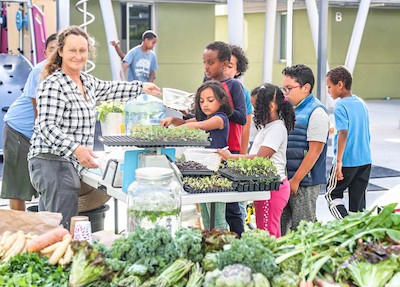
Our founder, Los Angeles County UC Master Gardener Carolyn Day established the program to reach out to people in need and help them restore their faith in themselves and society, while learning a great skill. We believe that time spent in contact with nature through these gardens adds meaningful, rewarding work and a safe environment for healing. While growing nutritious organic produce, our garden programs create a sense of belonging and the opportunity to make beneficial human connections. People are also connecting to the source of their food and cultivation practices that bring organic, sustainable, and seasonally appropriate food to their urban setting.
Our pilot project launched at Samoshel Homeless Shelter in Santa Monica in 2018. Mark, the self-appointed shelter resident/garden caretaker who first showed Carolyn the garden at Samoshel was also terminally ill. As he showed her the garden, he shared that he was dying and was sad because the garden was the most beautiful thing he had ever created—he was sure that it too would die when he was gone.
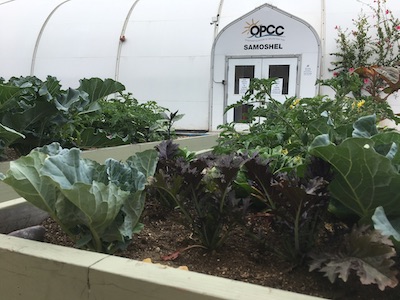
Carolyn remembers, “As we spoke, I was touched by how important this garden was to Mark during his time alive and dying. This experience propelled me to do research about the impacts of gardening on people of small means.” Two years after Mark's death, Growing Hope Gardens was founded.
Since then, we’ve installed four large ollas for irrigation at Samoshel—these extremely water efficient clay pots prevent excessive evaporation and water runoff in our hot and dry climate. The pots are buried in the garden and can be filled with water and/or collect rainwater, which gradually seeps into the soil to water the roots of the plants. In its second season, the garden is thriving and bringing joy to the residents and employees.
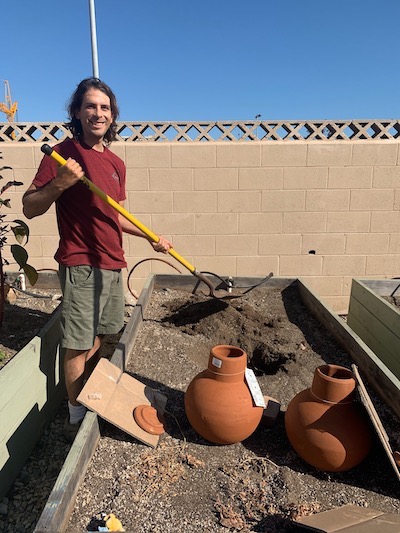
Our program provides residents with workshops on gardening and a paid position for current or former residents to increase stewardship, ensure the success of each garden, and provide ongoing maintenance at each site. The workshops educate through science-based gardening knowledge originated by Grow LA’s Victory Gardens Initiative. An opportunity for job training for our homeless population is valuable, because every job is preparation for an outside job. Hands-on education creates a network of neighbors of varied backgrounds in an outdoor space, which facilitates the sharing of cultures, plants, and gardening practices. By supporting adult, youth, elderly, and disabled participation in the gardens, we build community and the care for an overall shared living environment.
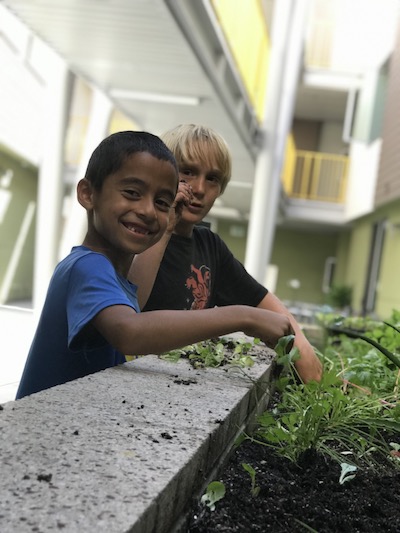
We care about people and the planet; there are incredible environmental benefits to our program as well. Gardens provide food locally, which eliminates the fossil fuels required to transport produce and decreases our dependence on fuel. We also capture storm water to decrease runoff, lessen our overall water use, curb erosion, and protect our local water sources.
By using regenerative and chemical-free gardening methods, we help mitigate our impact on the environment. Growing Hope Gardens fights climate change in each of our locations because our gardens increase the ability of soil to store carbon that would otherwise be released in the air to form CO2. In turn, this healthy soil increases biodiversity, attracting insects, pollinators, and abundant soil fungi. We are thrilled to have our gardens registered as Climate Victory Gardens with Green America because our organization is committed to using gardening to make healthy food, healthy community, and a healthy planet.
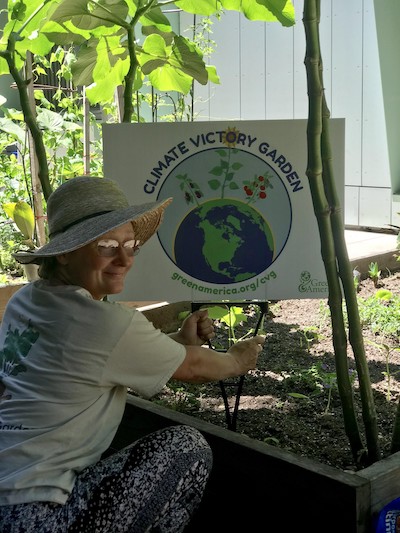
Our mission is to reduce the carbon footprint of each shelter, increase food system resilience, and encourage a sustainable, healthy lifestyle. To accomplish this, our programs are funded by our community, grants, and sponsors—we are happy to announce that we just received Los Angeles County Supervisor Khuel's “Food for the Soul” grant. This grant will fund three additional homeless shelter gardens, including maintenance and workshops until the end of 2020, as well as additional Community Garden Workshops and the launch of a mini urban farm alongside affordable housing.
Please consider starting your own organic and regenerative garden or work with an organization like ours to benefit your community and help others reap the benefits. Another inspiring organization to check out is the Homeless Garden Project. For more information on our program, please visit our website and follow us on Facebook.
Read more inspiring Climate Victory Garden stories and tips. |
|
Dama Distributing |
Dama Distributing is your Premium Sustainable Cannabis and CBD Packaging Provider. When it comes to choosing the right supplier, get what you need with Dama, while being Eco-friendly. Dama Disrtibuting delivers quality child resistant, Eco-friendly and compostable products to customers at affordable prices. With an impressive selection that’s continuously growing, we guarantee you’ll find what you need. We invite you to experience our revolutionary products. Please contact us with any questions or special requests.
|
|
Sustainable Events |
Picture the last event you attended. If it was like most events in the U.S., you probably noticed a lot of waste: food waste, plastic waste, printed waste, and more.
Sustainable Events LLC helps organizations and event professionals reduce the negative environmental impact of their events in order to preserve our planet and deliver powerful sustainability results.
The company provides a variety of waste-reducing services for events, including:
- Recycling programs
- Composting programs
- Food waste reduction & donation programs
- Floral donation programs
- Event supply donation programs
- Sustainability measurement & reporting
Since 2015, Sustainable Events LLC has kept more than 35,000 pounds of event waste out of landfills and incinerators. The company has also helped 4 events achieve “zero waste” status by diverting 90%+ of their waste.
Sustainable Events LLC was founded in 2015 by Julia Spangler, who is currently the company’s only employee. (The company operates under the trade name Julia Spangler, Sustainable Events Consultant.) In addition to event services, Julia consults with event planning professionals to help them understand and adopt sustainable practices.
Education is a key pillar of Sustainable Events LLC. To help event professionals get started with sustainability, Julia distributes free educational resources online, has created an online course about zero waste event planning, and delivers educational presentations to industry professionals about reducing event waste.
As a one-person business, Sustainable Events LLC is nearing its capacity for the number of events and clients it can serve. The prize from the People & Planet Award would support the hiring of a part-time event services manager who will help the business be able to provide sustainability services to more events.
|
|
Ink Forest |
Ink Forest believes T-shirts ARE the original social media. Posts on Facebook, Twitter or a picture on Instagram only last for minutes down a customer’s feed. A t-shirt will last for years. So, if you’re going to promote your business, club, school event or cause why not have them printed in an eco-friendly and sustainable manner.
“What is eco-friendly screen printing?” Eco-friendly screen printing encompasses much more than the use of water based inks. When running an eco-friendly or green screen printing shop you have to consider your supply chain. Knowing where all of your supplies, apparel, inks, solvents and equipment is made and that it is ethically sourced is what really makes it eco-friendly.
Ink Forest is a Certified Women Owned company specializing in non-toxic water based ink screen printing. We are committed to giving our clients high quality and durable screen printed apparel. Because water based inks do not contain PVC’s or Phthalates, your printed apparel is healthier for you and the environment. Ink Forest will use the People & Planet award to purchase larger equipment and to build a closed loop water system.
Why do I print this way? Because it’s the responsible thing to do and our clients love it!
|
|
Dean's Beans |
Dean’s Beans Organic Coffee Company’s mission has been clear for 26 years: To use high-quality, specialty coffee as a vehicle for positive change throughout the coffeelands of Asia, Africa and the Americas.
In 1994, we set out to prove that a for-profit business could create meaningful change through ethical business practices rooted in respect for the earth, the farmer, our co-workers and the consumer.
Our work starts with decades-old direct relationships with coffee farmers. From them, we source only organic, shade-grown coffee. This guarantees that the soil is pesticide-free, and that the farmer is protecting the soil and water quality of their farm. We also ensure the surrounding environment, including critical migratory bird habitat, is conserved, optimizing conditions for growing outstanding coffees.
Our business model is radical and, some say, totally backwards:
- We BUY HIGH and SELL LOW. We pay as much for that coffee as we can! Then, we sell it to the public as low as we can, so everyone has the opportunity to be a part of socially-just trade.
- We design and fund People-Centered Development projects in each community we work with, based on the communities’ chosen priorities. This award-winning approach focuses on the real needs of local communities for the ecological, economic and social necessities of life that are often disrupted by conventional development assistance.
Right now, many cooperatives identify climate resilience and food sovereignty as top priority. Together, we have created reforestation projects in Peru, Nicaragua, Guatemala, and Sumatra, setting up native fruit tree nurseries and planting over 350,000 trees to date. We are engaging young farmers in Guatemala to continue farming the land of their ancestors, while utilizing new technologies that offer solutions to a changing climate, as well as green jobs to a new generation.
We are currently scaling up our 20-year long agroforestry and water conservation project in Sumatra to save the critically endangered orangutan. Our “Reclaiming Sumatra” project includes purchasing land from palm oil plantations, cutting down oil palms and reforesting with indigenous hardwoods grown in nurseries we started with our farmers. So far this year, we’ve planted 11,000 trees.
The project is decreasing palm lands, increasing orangutan habitat, adding bird-friendly and carbon-neutralizing acreage around the coffee farms, and providing alternative income to the farmers growing and planting the trees. We will donate the Green America award to this project, immediately increasing orangutan habitat and sequestering carbon in Sumatra.
Dean’s Beans Organic Coffee Company is a certified Organic company, proud to work in cooperation with Fair Trade Federation and B Corps to promote business as a force for global good.
A proven pioneer in the field of social responsibility, social justice, sustainable practices and ecological stewardship, we ask you to join our movement. Together, we can brew great coffee and create real change.
|